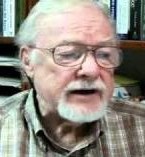A good example of the sort of news that is censored on the internet.
Did Six Million Really Die?
This information is fairly old (1988 and 1992) and pretty badly edited here, but nevertheless it’s an excellent example of the sort of news that has been censored on the internet for decades, and is censored even more so now on sites like Facebook, Wikipedia, and all of the zionist owned mainstream media.
I do have a copy of the book, but at 900 pages it’s too much information to include here in this post. I’ve posted this introduction here to troll anyone who hasn’t done any research on this subject at all, but who packs a hissy fit at anyone who calls bollocks on the six million story.
And if the whole six million is fake story is too controversial to cope with, another one that could really mess with a few heads is the nuclear lies controversy – talk about a can of worms!

In the early 1980s, Samisdat Publishers Ltd., under the signature of its president,
Ernst Zündel, published a 32-page booklet entitled Did Six Million Really Die?.
The booklet was published under a licence from Historical Review Press in England which
prohibited Samisdat from making any changes whatsoever to the publication.
Samisdat sent the booklet to hundreds of teachers, ministers, politicians and media
personalities across Canada in the hope that interest could be aroused in discussing
the subject explored in the booklet: did six million Jews really die pursuant to a
systematic policy of extermination by Nazi Germany during World War II?
Samisdat received no complaints regarding the booklet’s factual accuracy.
Nevertheless, in 1983, Samisdat’s president, Ernst Zündel, was charged under a
private information laid by Sabina Citron, a founder of the Canadian Holocaust
Remembrance Association, with the criminal offence of “spreading false news” likely to cause racial and social intolerance.
The charge was later assumed by the Crown and led to two lengthy jury trials in 1985 and 1988,both of which ended in convictions.
There is no doubt that Did Six Million Really Die? contained errors. It was written
hastily by a young University of London graduate, Richard Verrall (who used the
pseudonym “Richard Harwood”) in the early 1970s. The errors, however, were the
type of minor error which one can find in the first edition of any non-fiction book. For
example, Verrall wrote that the first allegation of mass murder of Jews was made
against the Germans in 1943 by the Polish Jew Raphael Lemkin. In fact, the first
charge of mass murder was made by the Allies in a Joint Declaration issued on
December 17, 1942. The error played no significant part in the argumentation of the
author. The significance and importance of Did Six Million Really Die? lay in its
logic, its reasoning and its opinions. It critiqued the weaknesses of the evidence and
arguments provided in orthodox “Holocaust” literature and it gave to the reader little-
known alternate views of what happened in the camps, such as those of Dr. Russell
Barton (who was present in Bergen-Belsen immediately after its liberation) and Thies
Christophersen (who was stationed near Auschwitz during the war). It summarized
the findings of the French revisionist historian Paul Rassinier, whose works at that
time were not known at all in the English-speaking world. In short, Did Six Million
Really Die? did what polemical works were meant to do: it provided the reader with
an alternate viewpoint on a historical event.
Two juries convicted Zündel notwithstanding devastating cross-examination of
Holocaust “survivors” and Holocaust historians by defence attorney Douglas H.
Christie and notwithstanding expert evidence which crushed the basis of the
Holocaust story, namely, the allegation that millions of Jews were done to death with
industrial efficiency in gigantic gas chambers and disposed of in crematories and
burning pits. It did not matter to the jury in the second Zündel trial in 1988 that the
warden of a United States penitentiary, Bill M. Armontrout, testified to the enormous
difficulties of gassing even one person today in gas chambers. It did not matter to the
jury that a forensic investigation of Auschwitz, Birkenau and Majdanek by the only
expert in gas chamber technology in the United States, Fred A. Leuchter, Jr., resulted
in Leuchter’s opinion that no gassings could have taken place in the alleged Nazi gas
chambers. It mattered not that the Canadian crematory expert, Ivan Lagacé, testified
that the thousands of persons alleged by Holocaust historians to have been cremated
in Birkenau and Auschwitz daily were “ludicrous” and “beyond the realm of reality.”
It did not matter to the jury that the internationally-known British historian David
Irving testified that he no longer believed in the “Holocaust” as it had been defined by
its historians. It did not matter that Holocaust historian Raul Hilberg refused to return
to testify in 1988 after testifying in 1985 for fear of cross- examination. It did not
matter that the Crown could not produce one expert witness in gas chambers or
crematories to refute the defence expert evidence.
If the evidence presented at the 1988 trial of Zündel was not enough to convince the
jury to acquit him, it was enough to start an explosive chain reaction of books and
studies into the veracity of the gas chamber claim. The evidence of Fred A. Leuchter,
Jr. and his report on the gas chambers at Auschwitz and Majdanek by far caused the
most reverberations. The Jewish Holocaust lobby at first ignored the Leuchter Report,
but as its influence mounted internationally, they scrambled to attempt to refute it.
The Beate Klarsfeld Foundation published the books Auschwitz: Technique and
Operation of the Gas Chambers and Truth Prevails: Demolishing Holocaust Denial:
the end of “The Leuchter Report.” The success of these books in “demolishing” the
Leuchter Report can perhaps be measured by the fact that almost no one has heard of
them; the mass media, usually so willing to use anything to smear Holocaust
revisionism, has virtually ignored them.
Apparently unable to find competent experts to support the gas chamber claim among
engineers and crematory experts, the Jewish Holocaust lobby turned the use of their
considerable resources instead to ensuring the destruction of Fred Leuchter’s career
and the passage of laws in France and Austria making “denial of the Holocaust” a
criminal offence. A full account of the tactics used against Leuchter can be found in
his article “Witch Hunt in Boston” (Journal of Historical Review, vol. 10, pp. 453-
460). While the Jewish lobby has succeeded in the political arena in having repressive
laws enacted against revisionism, they have not succeeded in refuting revisionism on
its merits, most importantly its technical and forensic evidence. The report of Fred A.
Leuchter, Jr., has engendered three further studies of the gas chambers.

Krakow Forensic Institute
In response to the Leuchter Report, the Auschwitz State Museum in 1990
commissioned the Krakow Forensic Institute to carry out an investigation of the
alleged gassing sites at the camp. The result of the testing of brick and mortar samples
fully corroborated the findings of Leuchter: the Institute found either no traces or
extremely small traces of cyanide in its samples. The Institute explained the test
results, however, by stating that it could not be assumed that cyanide traces would still
be detected after 45 years of being subjected to the weather and the elements. The
Krakow Forensic Institute also tested samples of hair from the Auschwitz Museum for
cyanide. The tests proved negative. (For a copy of the report and commentary, see
“An Official Polish Report on the Auschwitz ‘Gas Chambers'”, Journal of Historical
Review, vol. 11, pp. 207- 216).
Germar Rudolf
Germar Rudolf, a diplom chemist in Germany, investigated the sites of the alleged gas
chambers of Auschwitz and took samples for the purpose of determining cyanide
levels. Tests on the samples showed no or minimal traces of cyanide. Rudolf’s report
concluded, like Leuchter’s, that the alleged gas chambers at Auschwitz could never
have been used for gassings. Rudolf disputed the Krakow Forensic Institute’s
conclusion that the cyanide had been removed by environmental factors, pointing out
that it was well-known that cyanide compounds have enormous environmental
resistance. Ernst Zündel’s attempts to call Rudolf as an expert witness on charges in
Germany regarding the “Holocaust” were prevented by the German judge.
Walter Lüftl
Walter Lüftl is a professional engineer with a large engineering firm in Vienna and is
president of the Austrian Chamber of Engineers. In 1992 Lüftl wrote a report calling
the alleged extermination of millions of Jews in gas chambers “technically
impossible.” He pointed out that the design of the crematories themselves showed that
they were incapable of handling the number of victims alleged. “Corpses are not
flammable material,” wrote Lüftl, ” to cremate them requires much time and energy.”
These reports and other mounting evidence have shown the durability of the
conclusions stated in Did Six Million Really Die?. The booklet has proven to be, in
the words of Dr. Robert Faurisson, “prophetic.”
In 1988 Samisdat published Did Six Million Really Die?: Report of the
Evidence in the Canadian “False News” Trial of Ernst Zündel, 1988. The book was the
result of four years of work and summarized for the reader the evidence presented at
the second Zündel trial in 1988. That included, for the Crown, the evidence of
Holocaust historians Raul Hilberg (whose evidence from 1985 was read to the jury
since he refused to reattend personally) and Christopher Browning and the evidence
of Red Cross representative Charles Biedermann. For the defence, it includes the
evidence of the premiere revisionist historian today, Dr. Robert Faurisson, that of the
internationally renowned British historian David Irving, German historian Udo
Walendy, American historian Mark Weber, Canadian crematory expert Ivan Lagacé
and Canadian aerial photograph expert Ken Wilson. It included the evidence and the
report of Fred A. Leuchter, Jr., concerning his forensic investigation of the alleged gas
chambers at Auschwitz, Birkenau and Majdanek and the evidence of chemistry expert
Dr. James Roth concerning the cyanide content of samples removed from the alleged
Auschwitz gas chambers by Leuchter.
It summarized the evidence of the path-breaking Swedish revisionist writer, Ditlieb Felderer, and reproduces the revealing photographs of Auschwitz and Birkenau which Felderer showed the jury.
It is shocking that the persecution of Ernst Zündel continued for ten years and
with virtually no protest either in the intellectual or media elites of
Canada. These elites are apparently no longer interested in objective truth, but
interested only in maintaining the “political correctness” which will ensure access to
lucrative government and institutional positions, the continuation of government and
academic grants and the accolades of their like-minded peers. These elites did not
simply remain silent concerning the Zündel trials but participated in a feeding frenzy
of hatred against him simply because he had published a booklet questioning the
Holocaust. Few voices were raised in defence of intellectual freedom and its relation
to the workings of a true democracy. Instead, Zündel was attacked, vilified and
ridiculed. The media willingly censored the 1988 trial. The performance of these
elites in the Zündel affair has shown that they are unwilling to inform Canadians
honestly about controversial and vital issues which offend powerful vested interests;
indeed, it has proven their total corruption.
Ernst Zündel, in the foreword to the first Did Six Million Really Die?, wrote the
following words:
Truth has no need of coercion. Those who choose to ignore the truth are not punished
by law — they punish themselves. We of Samisdat Publishers do not believe that you
should be forced to read something, any more than we believe that you should be
forced not to read something…Whether you agree or disagree with the facts presented
in this booklet, we invite you to assist us in reclaiming and safeguarding the freedoms
we have all so long enjoyed, until now, in Canada…Without freedom of enquiry and
freedom of access to information we cannot have freedom of thought and without
freedom of thought, we cannot be a free people.
Today those words apply with even greater force as more and more individuals face
prosecution in Canada and Europe for their beliefs and opinions. Samisdat offers this
book to its readers in the hope that they will reclaim for themselves the right to decide
what is truth in history.
While Jewish organizations and the mass media expressed satisfaction that Zündel
had been convicted, many ordinary people in Canada were shocked at the
implications of the trial for freedom of speech and thought. In a letter to the Toronto
Sun, Lynda Mortl of Toronto wrote:
Why are we Canadians allowing a certain pressure group to act as censors for us? And
worse, to have a member of society brought to trial, probably jailed, and/or deported
for saying something we will not even be allowed to read. The more I think about the
implications of this trial, the more angry and frightened I become. I am one Canadian
who does not want Sabina Citron, Alan Shefman or Julian Sher to decide what I will
read or what I will call the truth.
Indeed, the purpose of the prosecution of Ernst Zündel was to make sure that ordinary
Canadians would not have access to the type of information contained in Did Six
Million Really Die?. Even today, Canadians do not realize how far the original
“Holocaust” story has disintegrated in the face of ongoing historical research and
forensic studies of the alleged Auschwitz execution gas chambers. The tight control of
information in this regard is a wonder to behold to those of us involved in this case.
Canadians who believe they enjoy a “free” press in North America are sadly mistaken.
There is never any attempt in the mass media to analyse why more and more people
no longer believe in the “Holocaust”; there is no transferal of any basic information to
the average reader to let them decide for themselves whether there is anything to what
the revisionists say or whether it is hogwash. Instead, Zündel and anyone else who
questions Holocaust claims are simply branded as “evil” and “hatemongers”.
This book ensures that both sides of this ethnic dispute are at least available to the
general reader. The record of the 1988 trial is unique in that the major historians on
both sides of the issue testified and were cross-examined relentlessly on their research
methods, bias, sources and findings. It records the only instance where Holocaust
historians have been forced to defend their assertion that the Jews of Europe were
exterminated (mainly in gas chambers) by the Nazi government during World War II.
For the reader it is a rare opportunity to see how in fact history is written, how indeed
history has become the tool of politics.
British historian David Irving testified that it is the reader who decides what
constitutes a “historical fact”; it is the reader who decides what has been proven to
happen in history and what has not. I therefore invite the reader to read the evidence
of one of the most significant trials of our century and with respect to the story of
what really happened to the Jews of Europe during World War II, to decide for
himself.
Barbara Kulaszka
August 1992
9
Foreword
by Dr. Robert Faurisson
Did the “Holocaust” of the European Jews really occur? Is it true that during the
Second World War, the Germans ordered, planned and carried out a policy of
physical destruction of the European Jews? More specifically, did they design, build
and use execution gas chambers for that purpose? Did they cause the deaths of
millions of Jews in that manner?
To these questions, the majority of writers say yes; they believe in the “Holocaust” of
the European Jews. We shall call these writers “exterminationists” because they
defend the thesis of the physical extermination of the Jews. To these same questions,
other writers say no; these writers are called “revisionists” but it goes without saying
that the revisionists do not dispute the fact that, during a world conflict which caused
40 to 50 million deaths, many Jews (the approximate number remains to be
determined) died.
Who is right? The exterminationists or the revisionists?
For the layman, there are, in principle, three main ways of forming a personal opinion
on a historical controversy.
The first way consists in reading the writings of both sides but in this specific case
that would require much time and revisionist literature is often difficult to obtain.
The second way is to attend a public debate between the two sides: the orthodox side
(the exterminationists) and the heterodox side (the revisionists). Unfortunately, the
exterminationists have always refused the public debate proposed to them by the
revisionists and which the revisionists continue to propose. In certain countries such
as France and Austria, the supporters of the exterminationist thesis have recently gone
so far as to obtain special laws that punish revisionists with heavy prison terms and
fines for “contesting” the existence of the “Holocaust” and the execution gas
chambers.
Fortunately, there remains a third way of forming an opinion on this controversy, that
of reading the transcript of a trial where the two sides found themselves face to face
before a judge and jury. In the case which concerns us, that is what happened twice, in
1985 and 1988, in actions brought against the revisionist Ernst Zündel in Toronto by
exterminationist members of a Jewish organization.
This remarkable book by Barbara Kulaszka rests upon the transcripts of the 1988 trial.
It will enable the layman to obtain a precise idea of the historical controversy
surrounding the Jewish “Holocaust” and to form an opinion for himself. I must,
however, express a reservation and issue a warning to the reader: a courtroom is not
an appropriate place for a historical debate. A trial has its own formal rules of
procedure and it is very limited as to time; freedom of expression is not total since one
of the parties is seeking to obtain a condemnation as the other party is trying to avoid
that condemnation. Finally, a judge and jury, even if they listen to experts, have
neither the competence nor the means required to settle a point of history.
I participated in the preliminary hearing of Ernst Zündel in 1984, in the first Zündel
trial in 1985 (quashed on procedural and substantive grounds), and, finally, in the
second Zündel trial in 1988. I published a complete account of the case in The Journal
of Historical Review, Winter 1988-1989, pp. 417-431 in an article entitled “The
Zündel Trials (1985-1988)”. I take the liberty of referring the reader to it but I would
also wish to quote here a passage from the article and to comment on it in the light of
what has happened since 1988. This passage deals essentially with my own discovery
in the 1970s of the chemical impossibility of the Auschwitz execution gassings and
the confirmation of that impossibility by Fred Leuchter. I wrote then:
For my part, I appeared as an expert witness for nearly six days. I concentrated
particularly on my investigations of the American gas chambers. I recalled that
Zyklon B is essentially hydrocyanic acid and that it is with this gas that certain
American penitentiaries execute those who have been condemned to death.
In 1945 the Allies should have asked specialists on American gas chambers to
examine the buildings, at Auschwitz and elsewhere, which were supposed to have
been used to gas millions of people. Since 1977, I have had the following idea: when
one deals with a vast historical problem like that of the reality or the legend of the
Holocaust, one must strive to get to the core of the problem. In this case the central
problem is Auschwitz and the core of that problem is a space of 275 square metres:
the 65 square metres of the “gas chamber” of crematorium I at Auschwitz and, at
Birkenau, the 210 square metres of the “gas chamber” of crematorium II. In 1988, my
idea remained the same: let us have expert studies of those 275 square metres and we
will have an answer to the vast problem of the Holocaust! I showed the jury my
photos of the gas chamber at the Maryland State Penitentiary in Baltimore as well as
my plans for the Auschwitz gas chambers and I underlined the physical and chemical
impossibilities of the latter ones.
A Sensational Turn of Events: The Leuchter Report
Ernst Zündel, in possession of the correspondence I had exchanged in 1977-78 with
the six American penitentiaries outfitted with gas chambers, gave attorney Barbara
Kulaszka the job of getting in touch with the chief wardens of those penitentiaries in
order to see if one of them would agree to appear in court to explain how a real gas
chamber operates. Bill Armontrout, chief warden of the penitentiary at Jefferson City
(Missouri), agreed to testify and in doing so pointed out that no one in the USA was
more knowledgeable about the functioning of gas chambers than Fred A. Leuchter, an
engineer from Boston. I went to visit Leuchter on February 3 and 4, 1988. I found that
he had never asked himself any questions about the “gas chambers” in the German
camps. He had simply believed in their existence. After I began to show him my files,
he became aware of the chemical and physical impossibility of the German “gassings”
and he agreed to examine our documents in Toronto.
After that, at Zündel’s expense, he left for Poland with a secretary (his wife), a
draftsman, a video-cameraman and an interpreter. He came back and drew up a 192
page report (including appendices). He also brought back 32 samples taken, on the
one hand, from the crematories of Auschwitz and Birkenau at the site of the homicidal
“gassings” and, on the other hand, in a disinfection gas chamber at Birkenau. His
conclusion was simple: there had never been any homicidal gassings at Auschwitz,
Birkenau, or Majdanek.
On April 20 and 21, 1988, Fred Leuchter appeared on the witness stand in the Toronto
courtroom. He told the story of his investigation and presented his conclusions. I am
convinced that during those two days I was an eyewitness to the death of the gas
chamber myth, a myth which, in my opinion, had entered its death throes at the
Sorbonne colloquium on “Nazi Germany and the Extermination of the Jews” (June 29
to July 2, 1982), where the organizers themselves began to grasp that there was no
proof of the existence of the gas chambers.
In the Toronto courtroom emotions were intense, in particular among the friends of
Sabina Citron. Ernst Zündel’s friends were also moved, but for a different reason: they
were witnessing the veil of the great swindle being torn away. As for me, I felt both
relief and melancholy: relief because a thesis that I had defended for so many years
was at last fully confirmed, and melancholy because I had fathered the idea in the first
place. I had even, with the clumsiness of a man of letters, presented physical,
chemical, topographical and architectural arguments which I now saw summed up by
a scientist who was astonishingly precise and thorough.
Would people one day remember the skepticism I had encountered, even from other
Revisionists? Just before Fred Leuchter, Bill Armontrout had been on the witness
stand, where he confirmed, in every detail, what I had said to the jury about the
extreme difficulties of a homicidal gassing (not to be confused with a suicidal or
accidental gassing). Ken Wilson, a specialist in aerial photographs, had shown that the
homicidal “gas chambers” of Auschwitz and Birkenau did not have gas evacuation
chimneys, which would have been indispensable. He also showed that I had been
right in accusing Serge Klarsfeld and Jean-Claude Pressac of falsifying the map of
Birkenau in The Auschwitz Album (Seuil Publishers, 1983, p. 42). Those authors, in
order to make the reader believe that groups of Jewish women and children surprised
by the photographer between crematories II and III could not go any farther and were
thus going to end up in the “gas chambers” and those crematories, had simply
eliminated from the map the path which, in reality, led up to the “Zentralsauna,” a
large shower facility (located beyond the zone of the crematories), where those
women and children were actually going.
James Roth, director of a laboratory in Massachusetts, then testified on the analysis of
the 32 samples, the origin of which he was unaware of: all the samples taken in the
homicidal “gas chambers” contained a quantity of cyanide which was either
unmeasurable or infinitesimal, while the sample from the disinfection gas chamber,
taken for comparison’s sake, contained an enormous amount of cyanide (the
infinitesimal quantity detected in the former case can be explained by the fact that the
supposed homicidal gas chambers were in fact morgues for preserving bodies; such
morgues could have been occasionally disinfected with Zyklon B). (pp. 428 430)
That happened in 1988. Four years later, the Leuchter Report was confirmed by three
other reports: first, that of the Krakow Forensic Institute; then, that of the German
Germar Rudolf, and finally, that of the Austrian Walter Lüftl. The most stunning of
these three reports is the one from Krakow. It had been pressed for by the authorities
at the Auschwitz State Museum in the hope that it would disprove the Leuchter
Report’s conclusions. The opposite happened and despite embarrassed explanations to
try to minimize the meaning of their own tests, the authors of the Krakow report
indeed confirmed — involuntarily — that Fred Leuchter was right. As a result, the
exterminationists prefer to treat the report of the Krakow Forensic Institute with
silence.
In 1989, the pharmacist Jean-Claude Pressac published, under the aegis of New
York’s Beate Klarsfeld Foundation, an enormous book entitled Auschwitz: Technique
and Operation of the Gas Chambers. I rendered an account of that exterminationist
attempt in The Journal of Historical Review in 1991 [Spring 1991, pp. 25-66 and
Summer, 1991, pp. 133-175]. I showed there that “the exterminationist mountain” in
labour had brought forth “a revisionist mouse.” The occasion gave me the opportunity
to emphasize again what I call “one of the 20th century’s great paradoxes”: that
millions of people, stupefied by incessant media propaganda, believe in the Nazi gas
chambers without ever having seen one, without having the slightest idea of what this
allegedly fantastic weapon was, without any ability to describe its shape and
operation. The Nazi gas chamber is alleged to have physically existed; yet no one can
provide us with a representation of it! This gas chamber is immaterial and magical.
Nobody, and above all, not J.-C. Pressac in his work with the misleading title, has
been able in a half-century to provide us with a photograph, a blueprint or a model.
The rare attempts in that direction have ended in failure. In their works, such men as
Poliakov, Wellers, Hilberg or Pressac have not dared — and for a good reason — to
reproduce a complete photograph of the alleged “gas chambers” which tourists can
visit in certain concentration camps. Nor do they reproduce the large mock-up which
tourists can see at the Auschwitz Museum’s Block 4, for they know that this is but a
grotesque trick. Thus, the challenge I have made to the adepts of the “Holocaust”
religion for decades remains the same: “I will be prepared to believe in the Nazi gas
chamber, the central pillar of the ‘Holocaust’ religion, on the day you can describe ‘a
single one of those gas chambers’ to me.” Sometimes I add: “But you are unable to do
so. Those chemical slaughterhouses where, according to you, one could have entered
with impunity to retrieve millions of bodies out of an ocean of hydrocyanic acid were
a physical and chemical impossibility. One cannot describe or draw the alleged
homicidal gas chamber of Auschwitz as one cannot describe or draw a square circle or
a circular square.”
Our age believes itself to be skeptical, believing only that which it sees. It claims to be
the age of television. Yet it believes in a material thing of which it does not have the
least material representation and never has a book, a movie or the television provided
us with an image of this material thing. The best way to deceive the masses is by
suggestion which entails auto-suggestion. Television cannot show or describe a Nazi
gas chamber but it suggests the idea; for example, it shows a building and the
commentary asserts: “Building containing a gas chamber”; or it settles for showing us
a simple shower sprinkler and like Pavlovian dogs we are conditioned, lo and behold,
“to see” a “gas chamber.” Other times, our pity will be aroused over some “hair of the
gassed”, “suitcases of the gassed”, “baby carriages of the gassed infants.” Thus do we
go from suggestion to auto-suggestion.
The myth of the gassing of civilians in enclosed places dates back to 1916; already, at
that time, the Germans, Austrians or the Bulgarians were accused of gassing Serbian
men, women and children. After the war, this myth was quickly overshadowed by the
myth of the Belgian children having their hands crushed by uhlans; it vanished only to
reappear twenty years later. This time the victims were no longer Serbs but Jews. And
it is this myth, absurd and painful, that at the end of the 20th century is persistently
imposed upon us.
In centuries past, people believed, likewise, in the devil, in his physical shape, in his
pales and tenterhooks, in his shouts and in his smells. Tribunals, chaired by judges
who reckoned themselves intelligent and enlightened, posited in principle (judicial
notice!) that such was true, so obviously true that demonstrating it was unwarranted.
Yet it was false. Smack in the middle of the 20th century, devilry came back and
judges who thought themselves more intelligent and more enlightened than their
predecessors of centuries past, posited in principle (judicial notice anew!) that the
devilish Nazi gas chambers had indeed existed. In Toronto in 1988, Judge Ron
Thomas took “judicial notice” of the “Holocaust” notwithstanding that this was the
very issue at the core of the trial where the matter was one of determining whether
Ernst Zündel was spreading false news or not when he distributed a piece of
revisionist literature entitled Did Six Million Really Die?.
I was a witness to Ernst Zündel’s judicial and extra-judicial calvary. This man is a
heroic figure of our time. He honours the German people of whom he was born. He
honours Canada where he came to settle. But Germany and Canada, without reason,
work against him at the instigation of the leaders of the world Jewish community. It is
a disgrace. As historian David Irving said so well: “The Jewish community have to
examine their consciences. They have been propagating something that isn’t true.”
(The Jewish Chronicle, London, 23 June 1989).
Under a simple exterior, Ernst Zündel has a visionary’s depth. This peasant of
Swabian origin, this artist, this businessman, casts a penetrating gaze on history,
society, politics, institutions and men. In my article on his trials which I have already
referred to, my conclusion had been the following:
Ernst Zündel had promised that his trial would be “the trial of the Nuremberg Trial” or
“the Stalingrad of the Exterminationists.” The unfolding of those two long trials
proved him right, even though the jury, “instructed” by the judge to consider the
Holocaust as an established fact “which no reasonable person can doubt,” finally
found him guilty. Zündel has already won. It remains for him to make it known to
Canada and to the entire world. The media blackout of the 1988 trial was almost
complete. Jewish organizations campaigned vigorously for such a blackout, and even
went so far as to say that they did not want an impartial account of the trial. They did
not want any account of it at all. The paradox is that the only publication which
reported relatively honestly about the trial was the Canadian Jewish News.
Ernst Zündel and the Leuchter report have left a profound mark on history; both will
be remembered for many years to come.
Today I would add that to me Ernst Zündel’s fate appears both more tragic and more
enviable than in 1988. It is even more tragic because I fear that the leaders of the
world Jewish community will not leave any respite to a man of this breadth, able not
only to discern what he calls truth, freedom and justice but also to struggle with so
much skill and courage for that truth, that freedom and that justice. In a general way, I
am pessimistic for the future of revisionists. But I am optimistic for the future of
revisionism: the work initiated by Paul Rassinier and crowned by the brilliant work of
the American Arthur Robert Butz, The Hoax of the Twentieth Century, has known,
thanks to Ernst Zündel, such a great expansion that no obstacle will be able to impede
its course. And it is in this sense that, notwithstanding everything, one can envy the
fate of Ernst Zündel.
Robert Faurisson
August, 1992
Here is a good example of what a researcher who fully looks into the story finds:
Free Speech, the Internet and Holocaust Revisionism
by Rae West 1997
http://www.big-lies.org/holocaust-revisionism/ww2-holocaust-revisionism.html
This is the text of a long talk I gave on 12th Oct 1997 at Conway Hall, in Red Lion Square, London, with a few additions. It was printed in the ‘Ethical Record’ in my heavily-edited form, from which however the conclusion was omitted. It’s online here Ethical Record, December 1997. It was based on Internet research, supplemented by cross-checking where possible with books and other documents published in the 1940s and 1950s. (Cf. the notes at the end). I had naturally assumed the revisionist case was nonsense, but being aware of the possibilities of systematic lying (cf. e.g. official downplaying and evasion of Vietnam War Crimes, also on this website—just one example) I considered I had an obligation to look into it. Where the information surprised me, in the sense of being diametrically opposite to the convention, I’ve flagged it, throughout this text. The conclusion I came to was that the ‘Holocaust’ was a largely or completely manufactured story.—Rae West
Introduction
Thanks to you all for coming. This is a complicated subject and I’ll do my best to do it justice.
Quotation
Let me start with an account:
‘According to the New York Times of October 3, 1965 there have been.. 170,000 civilians killed; 800,000 maimed by torture; 5,000 burnt alive, disembowelled or beheaded; 100,000 killed or maimed by chemical poisons; 400,000 detained and tortured savagely. One method of torture used by the American troops is partial electrocution or ‘frying’ as one United States Adviser called it—by attaching live wires to male genital organs or the breasts of Vietnamese women prisoners.’
‘Already 8,000,000 villagers are living in the 6,000 hamlets so far completed.. with bamboo fences, barbed wire, and armed militiamen.’
What’s the relevance of that? We’ll see later.
Outline
On the principle of ‘telling them what you’re going to tell them’, this is what I’m going to say:
First, some comments on Internet, since this is the source of this talk. I should make it clear I’m not obsessed by this topic and indeed only became aware of its existence a month or two ago. Many of the things said came as a surprise to me, and I’ll flag these during my talk. I’ll also supplement Internet with a few publications, of the sort readily available in second-hand bookshops.
Then some comments on free speech and the issues surrounding it, including technology. This is apparently a well-worn theme and I’ll try not to be too banal.
Then I’ll survey revisionism as a concept, and home in on holocaust revisionism, looking first at the types of revisionists.
Then I’ll go into detail as to the personalities involved, first the revisionists, then the anti-revisionists.
I’ll have to look at the Nuremberg Military Tribunal, and try to summarise the evidence brought by revisionists and by anti-revisionists.
I’ll end with political and historical comments (some addressed specifically to the left.)
The Internet
On Internet, opinions vary; Christopher Hitchens said it’s been tremendously oversold, you’ll get oligopolies and the same consumerist hogwash; he likes print. (Since writing that, it appears Hitchens knew for years he was a ‘Jew’—and not likely to advertise the liberation from Jewish lies of Internet). John Pilger said ‘look to see who controls the Internet; the American government and multinationals.’ I ought to point out that, in fact, it’s quite difficult to use; skilled computer people can store downloaded text on their computers for use later, but unskilled ones find this difficult; in my view, the promotional campaigns of the BBC’s ‘Computers Don’t Bite’ type are dangerously misleading; I’ve seen adults go into rages of frustration trying to work these things. There are dangers of losing all one’s work, and so on. In practice, most users seem to belong to institutions—typically students or employees who offload the costs onto their organisations. Many sites are maintained not by the people whose names appear there, but by associates or friends or whatever. Incidentally you’ll often be told that the quality of the material is very poor. In my opinion this isn’t true—the medium is purely verbal, there’s no way of making your points other than through well-chosen words, and the standard is generally not at all bad, though of course much of it is repetitive and rather silly. Incidentally many people don’t know there’s a subset of Internet called Usenet, consisting of thousands of interest groups, a bit like special-interest magazines.
Free Speech
On free speech, the amazing thing really is that such an ideology exists at all. You might expect any group having achieved some sort of dominance to oppose free speech, and generally this is true. Roughly speaking, without straining for precision, you might divide a population into well-off & poor, and also into intelligent and not intelligent; this gives four types, of which only two are likely to be interested in free speech; and of these, established people generally can’t be expected to favour free speech—King George V said ‘people who write books ought to be shut up’. That was his contribution to culture. Many important intellectual changes have therefore only been introduced by the intelligent not-well-off, for this reason; I’m thinking for example of Faraday. This is the pragmatic argument for free speech; something useful might come of it. But in practice free speech is something of a dead letter—and I’ll give this organisation as an example! So far as I know, in its 100 years, nobody at South Place has ever spoken on the financial resources of the Church of England. [Or of course the Talmud, and Jewish issues]. With critics like that, establishments can rest easy.
This sort of thing of course isn’t anything special; for example, democracy is more of a slogan than a reality; ‘free trade’ is generally a cover for the expansion of strong economies, and there’s an analogy with free speech, which may be a cover for pushing pornography or Hollywood tripe or what not.
Many of the theoreticians of free speech are more restrictive than is generally realised; Milton’s Areopagitica , at least according to Chomsky, advocates licensing of books rather than anything that would normally be considered free speech. John Stuart Mill would not (e.g.) allow the view that Queen Victoria should be assassinated, even by someone conscientiously convinced that it would be a good thing. So generally free speech is conceived in rather vague terms, and I think it’s fair to say nobody has come up with a theory to adequately deal with it. As a problematic issue you might take secrecy of banking, which seems more secure even than government, where there are at least 30 or 100 year rules on documents allowed to survive; but banks have no obligation to publish papers (as far as I know). And in practice censors don’t take a theoretical line; they just cut out anything that might be tricky.
One of the most important determinants of free speech is technological change; for example the Arab world had not one single printing press until the 1880s. In Britain, the Levellers broke up the Stationers Company monopoly, partly because printing was becoming easier. Similarly there’s a widespread belief that the Dutch were valuable in the 17th century, as permitting the publication of books banned in Britain and elsewhere. In my view this is probably a mistake—if you consider Dutch printers, they had the capacity to print books, but demand in Dutch of course was limited. So an Englishman with a bag of gold wanting 200 copies of a book on how terrible the Archbishop of Canterbury was would be an attractive proposition. Something similar appears to be the case with Internet; providers of it want to make money—or, if I’ve read the press aright, in most cases, want to lose less of it.
Technology is also important because the most up-to-date type looks reliable. About the time of the first world war, I’ve read, English people believed newspapers were ‘as reliable as encyclopaedias’, and this must have been a factor in promoting the war. Later, radio was the thing, and one finds for example Bernard Shaw, when he wasn’t writing in his garden shed, listening to his radio most of the time. This attitude still exists in some elderly people, who imagine the 1 o’clock BBC news to be the apex of accurate communication.
Revisionism as a Concept
Right. Let’s look at revisionism as a concept. As far as I know the word originated with Marxism, Bernstein starting the revisionist movement of the German sozialdemokratisch movement. Lenin wrote on this disapprovingly in (or before) 1908. There are no doubt religious revisionists too, considering e.g. whether Jesus Christ ever existed. But by now it’s extended into very many fields; in history journals I’ve found ‘revisionism’ applied to the Merovingians, Danes, and 19th century Wales. If we consider WW2, we find what we might call left-wing revisionists who point e.g. to Standard Oil of New Jersey, which seems to have supplied Germany with oil through the war, or Opel (the German branch of General Motors) making German armoured cars; I might quote Tony Benn:—
“I think it’s time we did a bit of reexamination, you know, of the 1930s and got away from the idea that the British government believed in appeasement. They didn’t .. appease Hitler. They supported Hitler. They backed Hitler. .. captured German foreign office you’ll find that when Halifax went to talk to Hitler on behalf of the British government the first thing he did was to congratulate the German chancellor on having destroyed communism in Germany, and acted as a bulwark against it in Europe. And the whole of that 1930s period was a period when western governments were happy to use fascism in order to destroy socialism in all its forms, not just in Russia but in the west as well. …”
Revisionists also look at the entire basis for war: Robert Blake, the Disraeli biographer, ‘Why Britain Went to War’:—‘It would be nice to say that Britain fought for ideals—democracy, freedom, the rule of law etc. But it would be untrue. Britain fought because government and people believed that its existence as a great imperial power was threatened.’ In America, Gabriel Kolko was, or should have been, very influential, on the American Empire.
Now. Until recently I’d more or less ignored what I’d thought of as right-wing revisionists. In fact, at least on the Internet, the word ‘revisionism’ now applies only to holocaust revisionism. For example, there’s a Usenet site called alt.revisionism devoted entirely to this topic.
However, I’ll look at the various distinctive people and groups which you find if you search using the key phrase ‘holocaust revisionism’ or ‘revisionist’.
Holocaust Revisionists’ Beliefs
First, for orientation purposes, I’ll try to summarise what the revisionists claim in common, the subset of beliefs that more or less unite them. These are actually fairly simple: the claims are that a deliberate extermination policy of Jews didn’t exist, that gas chambers are a myth, and that although lots of Jews died, the deaths weren’t proportionally more than other groups; Czechs, Poles, Ukrainians, Russians, various Baltic peoples; a quarter of all British merchant seamen. Those are the key beliefs, but of course, as you appreciate many other issues get brought in. Many of these issues are very well-established taboos indeed, but, as we’re in a sort of temple of rationalism, I’ll list a few which seem important; (i) that Jews actually are descended from Jews, (ii) that Jews took no special part in the Bolshevik revolution, (iii) that Judaism is a fundamentalist/racist ideology. Thus for example E H Carr’s series of books on the Bolshevik Revolution, which came out from the 1950s, has virtually no mention of Jews, despite purporting to be serious history; it’s rather like discussing former Yugoslavia without mentioning Moslems and Christians.
Types of Holocaust Revisionist
The next section is the longest; I’ll look at the most important revisionists, at least as far as I can judge by their Internet presences. First let’s see the motivations. There seem to be about ten categories: Some seem purely anti Semitic, for example posting more or less selective lists of what famous people have said about Jews—Voltaire, Henry Ford, George Washington, Mark Twain. Some are anti-Zionist and/or pro-Palestinians. There’s a group called Radio Islam of this sort; I’ll talk more about them later. Some are German-extraction Americans; I recall reading in a paper that a third of all Americans in the US claim German ancestry (whatever that means), and such people have a motivation of course for not being anti-German. There also seem to be white Russian or Polish types who consider Bolsheviks were Jewish, some of them Catholics (cf. Hilaire Belloc, the Roman Catholic who wrote his book ‘The Jews’ in 1922). There are anti-Communists, laying stress on Stalin’s crimes rather than Hitler’s. There are miscellaneous types including for example Protestant fundamentalists, blacks like Louis Farrakhan, and other black Americans, quite a few of whom seem to dislike American Jews, and also whites who think their power is slipping. It may seem strange to think of the 1930s or 1950s as a golden age, but then US cars led the world, the blacks were kept in their place, and so on. Another site is Michael A. Hoffmann II, who looks among other things at neglected aspects of history like white slavery in the US. There are groups who consider fairly taboo second world war issues, such as the connections between Zionism and the Third Reich. Common sense suggests there must be Polish or Hungarian or South African groups and others, but if so they’re not on Internet, or not much.
And there are, I presume, genuine truth-seekers, who are interested in truth in history, who might or might not be in some of the previous groups. I’ll concentrate on what I take to be people of this sort.
And here we come to my first surprise . Namely how old all this is. The first revisionists appeared at the same time as the Nuremberg tribunal which started in November 1945 and ended in 1949, producing 22 volumes of official transcript. Recently I was told (by a researcher into ‘AIDS’) that she’d heard the holocaust described as a myth in the mid-1970s, by an American, on a journey on the trans-Siberian railway. My second surprise is how industrious some revisionists are—many have been doing this for years. E.g. the Swede Ditlieb Felderer says he has 30,000 slides, some in infra-red, taken at all the concentration camps. The Frenchman Faurisson seems to have spent years following up reports and interviewing, or trying to interview, people. Another example is David Irving, the self-trained document historian, who has amassed mountains of documents and has a card index of 10,000 separate items, arranged by date, so he can see what happened on any date he’s interested in. Perhaps more cards by now. However I should add that Irving doesn’t claim to be a holocaust revisionist, strictly speaking; the holocaust appears as something of a side-issue in his work on original documents. However, with that proviso, I’ll include him here since his work on the biographies of e.g. Hitler, Churchill, and his book on Goebbels, which seems to have been banned, is so relevant. He is somewhat looked down on by some holocaust revisionists as late as 1977 in ‘Hitler’s War’ he believed in the holocaust.
Internet Revisionists: Survey by Countries
The first name I’ll mention is Professor Paul Rassinier, a Frenchman, now dead, who was in concentration camps for much of the war. Depending on your taste, he was a socialist who turned to fascism after the war, or a socialist who didn’t believe accusations being made against the Germans and published quite a few books on the subject. So far as I’ve found out, his first book was 1949 Le Mensonge d’Ulysse, and the only one translated into English was The Drama of the European Jews, trans 1975 by Harry Elmer Barnes, a sociologist from Chicago university. He also wrote on the Eichmann trial.
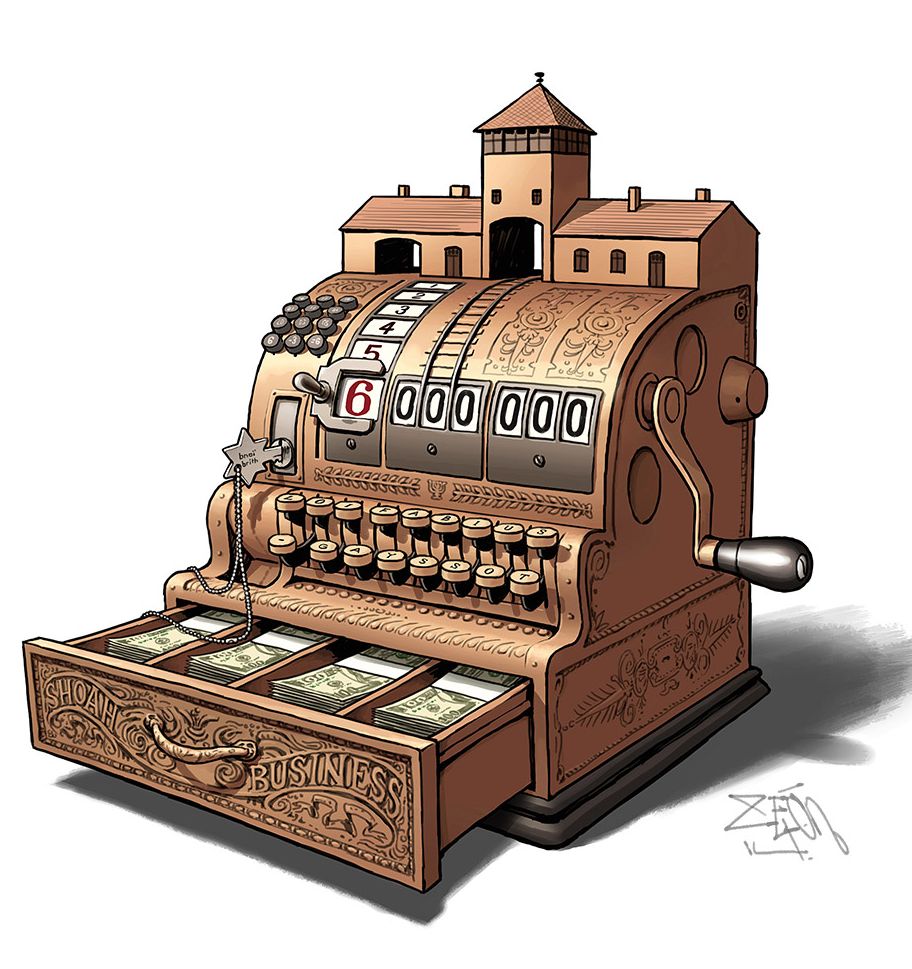
Cartoon from 2nd Holocaust international cartoon exhibition in Teheran, Iran. By Zeon, of France. The cash register, surmounted by a model of part of the Auschwitz-Monowitz complex, has ‘SHOAH BUSINESS’ on its drawer, with the ‘6 000 000’ figure (not the far higher cash sums extorted), with LOI FABIUS-GAYSSOT on its keys.
Rassinier (and another man, Bardèche) seem to have started what I might call the French school, which includes Robert Faurisson (of Lyons—the man whose book had a preface on free speech signed by 100 people, including Chomsky, and for which act Chomsky received endless attacks. Chomsky incidentally said he never read the book and didn’t know anything in detail about the subject, though he accepts the mass killing idea). Rassinier influenced Faurisson, according to Faurisson, by replying in detail to Faurisson’s letters when anti-revisionists were evasive. And also Roger Garaudy (described as an ex-Marxist ‘theoretician’, now a Catholic) [Several people have pointed out to me he converted to Islam-RW]. Incidentally in France under the Gayssot-Fabius law, passed in 1990, it is a criminal offence “to contest by any means the existence of one or more of the crimes against humanity as defined by Article 6 of the Statutes of the International Military Tribunal, attached to the London Agreement of August 8, 1945, committed either by the members of an organization declared criminal in application of Article 9 of the same Statutes, or by a person held guilty of such a crime by a French or international jurisdiction.”
Faurisson is a literature professor (I’m not sure what that status means) whose writings don’t in my opinion read very well in English, paying minute attention to documentary oddities. However I think he claims to be the first person to assert that gas chambers were a myth.
There’s no German school—in Germany and Austria the entire topic is banned under a law apparently passed by Hitler. So far as I gather this law prohibits any discussion of the holocaust, which is simply stated to be a historical fact. However, there are isolated Germans, including Wilhelm Staeglich (a judge who published The Auschwitz Myth in 1979 in German), Udo Walendy who has published on what he says are fake photos, and several historians of the second world war.
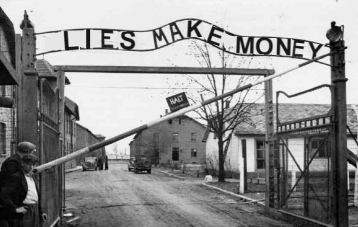 The English revisionists seem rather unimportant (Note Jan 2015: I may have underestimated Douglas Reed] as regards original work; the book ‘Did Six Million Really Die?’ (1974—added 2012: 5th edition, 2011, revised, updated, and expanded, is published by historicalreviewpress.com though it is not stated whether the original author(s) were responsible for the added work) was originally published pseudonymously, by ‘Richard Harwood’ but apparently by a London University graduate called Verrall & others. It was reviewed by Colin Wilson, who’s mostly an ‘occult’ writer, in Books & Bookmen in the same year, causing months of controversy. It is mostly translated from French sources, I think. Another man I’ll mention is Dr Russell Burton, a medical doctor who was in Belsen in 1945 and wrote an article in something called Purnell’s History of the Second World War, in which he maintained the deaths were caused by intense overcrowding—53,000 people in a camp designed for 3,000—and typhus. Burton is not, or was not in 1988, a revisionist in a sense; he accepts the usual figure for Jewish deaths but not I think gas chambers.
The English revisionists seem rather unimportant (Note Jan 2015: I may have underestimated Douglas Reed] as regards original work; the book ‘Did Six Million Really Die?’ (1974—added 2012: 5th edition, 2011, revised, updated, and expanded, is published by historicalreviewpress.com though it is not stated whether the original author(s) were responsible for the added work) was originally published pseudonymously, by ‘Richard Harwood’ but apparently by a London University graduate called Verrall & others. It was reviewed by Colin Wilson, who’s mostly an ‘occult’ writer, in Books & Bookmen in the same year, causing months of controversy. It is mostly translated from French sources, I think. Another man I’ll mention is Dr Russell Burton, a medical doctor who was in Belsen in 1945 and wrote an article in something called Purnell’s History of the Second World War, in which he maintained the deaths were caused by intense overcrowding—53,000 people in a camp designed for 3,000—and typhus. Burton is not, or was not in 1988, a revisionist in a sense; he accepts the usual figure for Jewish deaths but not I think gas chambers.
[Note added Sept 24 2013: the book starts with a complaint to the effect that Britons opposing the immigration of aliens into Britain wanted to kill them! This seems part of Jewish methodology in addition to fake claims of persecution. Very likely it reflects Jewish attitudes, since the Talmud and other material explicitly calls for killing of Christians and others.]
As regards USA, because of the important part played by the US in the Nuremberg Tribunal, and doubts about them emerged quite early on. 1947 to 1951; we’ll look at this later. There were several books (one published anonymously but apparently by David Hoggan, 1969, and one by Austin App, 1973) but the most important known to me is Arthur Butz, a chemical engineer [in fact I’m told a professor of electrical engineering and computing – RW], who published with an obscure publisher The Hoax of the Twentieth Century in 1975, his methodology being to order original documents through US inter-library loan systems. He has a lot of material involving American politics. Butz has an Internet site, but his book is not available on his site, perhaps because he’s still selling it. His chemical engineering background enabled him to take a long look at the technical side of Auschwitz as a manufacturing plant, the sort of thing which historians generally are unable to do. So far as I know, no legal action has been taken in the U.S. over this.
Incidentally my third surprise is the obscurity of almost all the people involved in this dispute, in the sense that very few are official historians, on either side. You might imagine that the supposedly heavyweight historians, e.g. Alan Bullock or Trevor-Roper (Dacre) or Hobsbawm, would weigh in from their supposedly Olympian heights, since the received impression is they have enormous amounts of evidence which they could easily produce. You might imagine this, but it doesn’t happen.
From the viewpoint of Internet users, Canada has one of the largest sites; this is because of Ernst Zündel, a naturalised German born in 1939 who has a site called the ‘Zundelsite’ in Toronto. This contains the complete text of ‘Did Six Million Really Die?’ (which Zündel started to distribute in 1980) and also a trial transcript, the outcome of two trials of Zündel in 1985 (7 weeks) and 1988 (four months). This incidentally is about the same time as Mordechai Vanunu’s abduction, and imprisonment in Israel. The suit seems to have been brought by Sabina Citron of the ‘Canadian Holocaust Remembrance Association’ and Simon Wiesenthal. The second trial transcript is available on Internet; it has five major testimonies, each about 400K long, that’s about half the length of a novel like say Lord Jim , each. There are other shorter testimonies too. The two main prosecution witness were Christopher Browning, an American professor of history, and Raul Hilberg, b 1929, a prolific author on the holocaust; the three main defence witnesses (judging by length) were Faurisson and Mark Weber, I presume a German-American, and David Irving. Another significant witness was Fred A. Leuchter, an American designer of execution equipment, including gas chambers, for which there seems considerable demand in the USA. At this point I register surprise #4 : amazingly, there seems never to have been any official technical examination, or even description, of the gas chambers.
I had intended to include part of Raul Hilberg’s cross-examination, in dramatised form, to give you a change from my voice, but there seems not to be time for this. However, I found it surprisingly unimpressive; for example Hilberg admitted he’d never been to any of the concentration camps except on a day-trip or two. The impression I received from this trial of Zündel was that it went wrong from the prosecution point of view, somewhat in the way the McDonald libel trial twisted out of their control.
Zündel was found guilty on both occasions and I think jailed. He is provocative, though whether as a cause or effect I don’t know. His site has a logo of a white circle on red, with the letter Z at an angle, unmistakably resembling half a swastika in perspective. Since he is or was a commercial artist, I presume he designed this himself.
The other large Internet site is ‘Radio Islam’; I’m not sure if it actually has a radio broadcasting branch. It seems to be based in Sweden. It includes holocaust revisionism as a subset, but has other material, including the complete text (with map) of Arthur Koestler’s 13th Tribe , which more or less for the first time popularised the idea that the Khazars, a tribe or group living north of the Black Sea and the Caspian were converted to Judaism from above by their Khan in about 750 AD. This is not an original idea of Koestler’s, but brings together the work of many obscure scholars e.g. Paul Erich Kahle in a popular essay, but written in a longwinded style with many digressions which makes the message difficult to decipher. In effect, he says European Jews aren’t racially Jews at all. I once wrote to Jonathan Sacks, the chief Rabbi, about this, and received back a book review, beginning unpromisingly by comparing Koestler to a crab with two giant claws. Anyway this theory can be assumed to be viewed with Rabbinical disfavour. Radio Islam also has Roger Garaudy’s Founding Myths of Israeli Politics, 1996, more or less banned in France, although it was published by Le Vielle Taupe (‘The Old Mole’). Other topics include: ADL (anti-Defamation League)’s suspected links with Mossad. Deir Yassin massacre 1948 and other massacre accounts. Marlon Brando saying Hollywood is run by Jews. Unflattering things on Zionism. Wannsee Conference of 1940 which it says is a fabrication, little more than a sheet of paper without authentication of any kind. It also less accountably has the ‘Protocols of the learned elders of Zion’ (the basis of Norman Cohn’s very disappointing book 1967 book ‘Warrant for Genocide’.
Other sites include: CODOH (Committee for Open Debate on the Holocaust) PO box in California, Campaign for Radical Truth in History (Michael A. Hoffmann), Institute for Historical Review (California). Also someone called Greg Raven—there seems to have been a lot of behind the scenes manoeuvring in these organisations. Another group is called the Adelaide Institute but they seem a bit elusive. I haven’t been able to find much out how they are funded.
Anti-revisionists
Well, that’s our survey of the revisionists. Let’s now look at the anti-revisionists, though not all would call themselves this. Their opponents call them ‘exterminists’. As I said before, the surprise really is how obscure these people are. There’s one main organisation, called Nizkor, N-I-Z-K-O-R. This is by far the most important; others include skeptics group, of the sort typified by James Randi and CSICOP, the people who investigate the paranormal but perhaps sensing there’s limited scope in astrology and spoon-bending have branched out into e.g. medical topics (getting into deep water as shown e.g. in Martin Walker’s book Dirty Medicine ) and, as here, holocaust revisionists. The main person here is Michael Shermer, who has posted an article on David Irving. I won’t say anything more about him as his work is derivative. Incidentally there’s a UK magazine more or less on this topic, called Searchlight , from which I fairly recently heard a speaker discuss whether there should be a law in Britain against holocaust revisionism. The specimen copy I bought dealt with pop music and Nazi imagery. I think the title might be a riposte to Spotlight , published by ‘the Liberty Lobby’. I’ve heard it suggested it’s an MI5 (or is it MI6?) production, admittedly from a not very good source. However, as I say, Nizkor is the main anti-revisionist Internet group, so I’ll concentrate on them.
Several names appear relating to Nizkor, Daniel Keren, Jamie McCarthy, Ken McVay, who seem to be full-time employees; I’m uncertain even if the names are genuine. I don’t know whether they claim any originality. As an example, Ken McVay posted on the ‘Institute for Historical Revisionism’ e.g. this was founded in 1979 by Lewis Brandon, who in 1975 founded Britain’s National Party. Someone called Willis Carto is connected with it, who funds it, founded ‘the liberty lobby’ and whom McVay describes as ‘by far the most successful and influential American anti-semite of the 1970s.’)
I repeat that most of these people are somewhat obscure. The next three I’ll discuss are all French: a Nizkor site called ‘Hatewatch’, which conflates revisionism with skinhead and racist violence, neo-Nazis, and similar topics, leads on to three essays by Pierre Vidal-Naquet, Nadine Fresco, and Lin Collette. Pierre Vidal-Naquet’s essay is in English translation ‘Assassins of Memory’. By coincidence, I came across him in a book by Peter James, the chronology revisionist of the ancient world; Vidal-Naquet is a classicist in the traditional Greco-Roman sense and his 1987 article has references to the Peloponnesian War, Sparta, George Grote, Thucydides, as well as Algeria and the post-war French group Socialisme ou Barbarie. He says there’s ‘nothing more common in history, more sadly banal, than massacres’. I couldn’t find much in the way of direct argument here. Nadine Fresco’s 1990 article is ‘The Denial of the Dead: On the Faurisson Affair’. She seems to be a journalist on Les Tempes Modernes. This is mostly on Faurisson and Chomsky with excursions into French authors. Both these authors quote Johann-Paul Kremer, a doctor at Auschwitz, who however so far as I can find seems to have given testimony to both Nuremberg and Polish communist courts and to have subsequently retracted some of it before being hanged.
The third of the three Hatewatch essays is by Lin Collette, called ‘Encountering Holocaust denial’. She is or was described as a doctoral candidate in religious studies at the Union Institute, Cincinnati. Her article deals with whether an advert should have been placed by Bradley R. Smith of the Committee for Open Debate on the Holocaust in student newspapers. She discusses the Ku Klux Klan, American tolerance, and so on.
Perhaps more impressive is Deborah Lipstadt who wrote a 1993 book Denying the Holocaust: the Growing Assault on Truth and Memory. She’s in the ‘Dorot chair in modern Jewish and Holocaust Studies’ at Emory University, which is in Atlanta, Georgia. This book is much reviewed on Internet; I found about eight reviews. Incidentally David Irving is involved in a libel case with her and Penguin books, what he calls her ‘odious little tract’, and her books are stocked, Irving’s not, by Waterstones [a British bookstore chain]. Her book isn’t on Internet and I’ve only been able to find scattered quotations there.
In a way of course they hardly need to put material on the Internet, as there’s a huge array of holocaust literature; here for example is ‘The Scourge of the Swastika’ by Russell of Liverpool, which was marketed almost like pornography; (1954), ‘The Nuremberg Trial’ by Ann & John Tusa (1983), ‘The Battle for History’ (1993) by John Keegan.
There are countless books of a rather vague derivative type, mostly based on the Nuremberg trials, by such authors as George Steiner (‘literary critic’), Bruno Bettelheim (‘psychoanalyst’), Gerald Fleming (a German who was invited to read the newly-opened Polish & Russian archives, but was something like an assistant in the audio-visual department in the linguistics department at Surrey University, not a historian at all.)
There are also what are, or may be, memoirs, such as Elie Weisel (writer), Primo Levi (chemist) who’s now dead. Quite a few memoirs have been written many years, ten or twenty or more, after the events in them. ‘Médécin Auschwitz’ Miklos Nyszli 1953, ‘Kommandant at Auschwitz’, supposedly the memoirs of Höss, came out in 1958; Olga Lengyel ‘Five Chimneys’ in 1959.
Raul Hilberg, main book 1961, The Destruction of the European Jews .
Martin Gilbert (e.g. biographer of Churchill—his book doesn’t mention the fact that Churchill’s mother was Jewish, as appears to be the case), assisted with this 1995 booklet, ‘A History of the Holocaust’.
Leon Greenman who spoke here in 1994.
And of course there’s a huge fictional output—the Odessa File, to Schindler’s List.
Five Revisionist Disputes
That’s something like the personal line-up you’ll find on Internet; if you look at it, you’ll recognise most of these names. Now I want to turn to the actual claims made by revisionists, in a fairly brief but I hope accurate way. I’ll take five subjects: the meaning of ‘final solution’, problems with the Nuremberg trials, the issue of fake documents and photos, the problem of population figures, and the gas chambers. OK. Here we go.
1. ‘Final Solution’
What does ‘final solution’ mean? There are endless debates reminiscent of A J P Taylor’s remark that the question perhaps was what was meant by a ‘plan’. For the sake of brevity I’ll confine myself to the word ‘endlosung’. This was used in many German documents and speeches; nobody disputes this. Unfortunately its meaning seems to be ambiguous and also to have changed over the years. It could mean extermination; but it could mean uprooting. The revisionist view is that ‘final solution’ meant expelling Jews from Germany; they seriously considered Madagascar as a destination. According to David Irving, Eichmann went to Palestine in 1939 to negotiate with Zionists there for a removal. Revisionists support this by asserting that throughout the war Germany was willing to do deals sending Jews out. There’s a suggestive comparison I might make with the with miners recently; no one suggested killing them; the object was to make them unimportant in power terms. David Irving seems to have been the first person to definitely assert that Hitler never issued a command with an explicit word like ‘kill’. However it’s important to realise that the Nazis regarded the Soviet system as Jewish-run; when they invaded the Soviet Union on June 22nd, 1941, they were accompanied by battalion-size units of Security Police and Security Service. These units, called ‘Einsatzgruppen’, had explicit instructions to kill ‘commissars and Jewish Bolshevik chieftains’
2. Problems with the Nuremberg and International Military Trials
On Nuremberg, and this is another of my surprises, number 5 , it’s disconcerting to find evidence that the best-known and most horrifying confessions, the damning ones, seem to have been obtained only with torture. I asked my elderly father what he could remember about the news treatment of this, and he said the impression given was of a proper trial—men in robes or uniforms or wigs or what have you. None of the leading defendants [29 August 1945: Goering, Ribbentrop, Hess, Kaltenbrunner, Rosenberg, Frank, Bormann, Frick, Ley, Sauckel, Speer, Funk, Schacht, Papen, Krupp, Neurath, Schirach, Seyss-Inquart, Streicher, Keitel, Jodl, Raeder, Doenitz, Frisch. The Press approved ..] said they’d had anything to do with death camps; the most famous was Höss, kommandant of Auschwitz. However, in 1983 a book by Rupert Butler, ‘Legions of Death’, revealed that his confession was obtained after three days of torture. This is apart from other problems, such as the main document being typed in English.
This is not new knowledge; some anti-revisionists state such things have only recently been discovered. But this seems to be a complete lie. I found three references: An interview with Judge Edward L. Van Roden, in ‘The Progressive’ February 1949/ Morris W Kolander in Pennsylvania Bar Assn Quarterly April 1947/ Manstein: His Campaigns and His Trial written by Field-Marshal Erich von Manstein’s defence lawyer R.T. Paget, K.C., M.P. (1951).
Paget wrote: p. 109: This commission, consisting of Judges Simpson and Van Roden, and Colonel Laurenzen had reported among other things that of the 139 cases they had investigated 137 had had their testicles permanently destroyed by kicks received from the American War Crimes Investigation team.
Names given: Lt.-Col. Burton F. Ellis (chief of the War Crimes Committee) and his assistants, Capt. Raphael Shumacker, Lt. Robert E. Byrne, Lt. William R. Perl, Mr. Morris Ellowitz, Mr. Harry Thon, and Mr. Kirschbaum. The legal adviser of the court was Col. A.H. Rosenfeld.
It’s disquieting to find the Tusas book on Nuremberg mentions none of this; none of these people are indexed or appear anywhere in the book.
Another irritation of the Tusas’ book is this sort of thing: the defendants’ list ‘named the wrong Krupp: Gustav. He was only a Krupp by marriage.. .. from 1943, by agreement with the Nazi government, Alfried had become the sole owner of the firm .. .. it was undoubtedly a slip of the pen—early lists of defendants had used Alfried’s name…’ [p 138 says Gustav Krupp was bedridden]
pp 139-140: [The Tribunal was supposedly horrified at the suggestion Alfried Krupp should be substituted, for his father, ‘a practice unacceptable in any court.’
By 144, this becomes ‘an old canard’] The Tusas’ claim seems nonsense, since the IMT were making up the rules as they went along; it seems absurd to suggest they would hesitate to correct a misprint.
Yet another aspect is the fact, or allegation, that the American consisted mostly, at least 9 out of 10, Jews, mostly straight from Europe, not in any serious sense Americans at all. The Tusas give virtually no information about the American prosecution team.
And another aspect is that Nuremberg was rigged: (A) the Prosecution controlled all documents; (B) no cross examination of witnesses, so any written statement could be submitted without ever being checked; (C) torture was applied to witnesses.
Nuremberg procedures are little mentioned, for example in TV ‘documentaries’. At the time, this was possibly an aspect of wartime censorship; obviously there was intense censorship during the war, and probably the habits and the personnel continued. There were of course secret issues, such as German personnel, equipment and patents taken from Germany.
3. Fake Documents and Photographs
On fake documents and pix, I’ll just list some fakes, a small set taken from a long list, claimed by David Irving, armed with his card index. ‘Several works hitherto accepted as ‘standard’ sources—Konrad Heiden, the Abwehr/OSS double agent Hans Bernd Gisevius, Erich Kordt, Hitler’s dismissed adjutant Fritz Wiedemann. Professor Carl-Jakob Burckhardt’s ‘diary’; while Hermann Rauschning’s Conversations with Hitler (1940), West German historian Professor Eberhard Jaecel—who carelessly included 78 forgeries in a serious volume of Hitler’s manuscripts, Fritz Thyssen’s ‘memoirs,’ I Paid Hitler (London, 1943). The anonymous ‘memoirs’ of the late Christa Schroeder, Hitler Privat (Dusseldorf, 1949) were penned by Albert Zoller, a French army liaison officer to the U.S. Seventh Army. Martin Bormann’s alleged notes on Hitler’s final bunker conversations, published with an introduction by Professor Hugh Trevor-Roper in 1961 as The Testament of Adolf Hitler are in my view quite spurious. Albert Speer’s Inside the Third Reich made him a personal fortune after the West Berlin firm of Propyläen published the book in 1969. They earned him wide respect for his disavowal of Hitler. But some critics were puzzled that the American edition differed substantially from the German original.. A courageous Berlin author, Matthias Schmidt, later published a book exposing the Speer legend and the ‘memoirs’; two different men claimed to possess the entire diaries of Vice Admiral Wilhelm Canaris, the legendary Abwehr chief hanged by Hitler in April 1945…. The genuine Kersten diaries which Professor Hugh Trevor-Roper saw in Sweden were never published, perhaps because of the political dynamite they contained on Sweden’s elite, including publisher Albert Bonnier, alleged to have offered Himmler the addresses of every Jew in Sweden in return for concessions in the event of a Nazi invasion. Per contra Irving alleges that the Israelis have authentic diaries of Himmler which they will not allow anyone else to examine.
He doesn’t mention another possible motive for bombing housing: it left factories alone. After the war claims were made on damage, ownership etc of factories and presumably other assets, such as railways, in Germany. [Inserted 5 Aug 2015 – RW]
On photos, the source prominent on Internet is Udo Walendy. He gives examples of photos misattributed and with their backgrounds changed and so on. And film: for example a doctor in a film supposedly at a camp recognised himself at a scene of burning corpses after Dresden bombing.
I haven’t seen Walendy’s book. Of course faking propaganda isn’t new; Arthur Ponsonby’s 1928 Falsehood in Wartime included an account of a French firm making atrocity films, I think in the Bois de Boulogne, on sale to anyone.
4. Population Figures
Now let’s look at population difficulties. This reveals a weakness of both sides. Reliable figures seem impossible to get. On the one hand, there was the chaos of war, with vast migrations and also changes of border. Also the Nazis had their own definition of Judaism which may not have been accepted by people so labelled. On the other hand, it remains true that states still retained bureaucracies and passport systems. Various revisionist estimates for numbers of Jewish victims have been made; I’ll just give three, one by Felderer who so far as I recall estimated 200,000, using UN figures for populations. Rassinier gives a figure of 900K – 1.2 M. ‘Did Six Million Really Die?’ by using encyclopedia figures gets an absolute maximum of 1.5 M.
I’ll also note that the 6 million figure and the word ‘holocaust’ were used earlier; the first rather vague reference I found is 1919 (see below).
Note also that US immigration figures aren’t very usable because the category ‘Hebrew’ was discontinued in November 1943, and ‘no official record has been keep since then’ at least according to a 1947 book on refugees by Maurice Davie.
[Note added January 2015: British journalist and novelist Douglas Reed was the first prominent person to expose the fraudulent “Holocaust” propaganda narrative. The World Almanac of 1947 showed that the jewish race increased in population from the year 1937, not decreased is a statement by ‘Jim Ferguson’ who cites How Many Jews? online as the source. Far and Wide (1951) is also cited in the ihr website. Many Internet sites seem unable to understand the importance of exact citings.]
So this is another surprise, my sixth : no proper examination of demography ever seem to have been made. Figures quoted by Martin Gilbert in this booklet [copy of glossy booklet, A History of the Holocaust ] are 1978 figures and seem based only on Nuremberg evidence; at any rate no sources are given.
5. Gas Chambers
Gas chamber & translation problems; e.g. ‘gasungskeller’. this is complicated by the existence of precautions against gas warfare. There’s a large literature, including most famously a book 1989 called Technique and Operation of the Gas Chambers , Jean-Claude Pressac which I haven’t been able to get hold of, as it wasn’t in my sample university library (my hunting suggests very few revisionist books are held anywhere). I won’t attempt to summarise the dismal material on capacity of rooms, dangers of using cyanide, time taken to cremate bodies, in all of which the revisionist case seems to me strong. I’ll mention though my final surprise #7 : there appears to be not one authenticated photograph of a gas chamber designed for human beings.
BWP [ British Way and Purpose , a British Army wartime collection of morale-boosting papers] has a brief mention which seems to confirm that extermination stories were taken very seriously. (Nov 1942-May 1944). This is often interpreted as deliberate evasion of responsibility.
Later on the liberation of German camps was reported by e.g. Richard Dimbleby. Here’s a BBC book of the time, with a piece called ‘The Man from Belsen’. There’s mention of hard work and some violence, but the deaths in the camps seem to be caused by starvation as a result of bombing, chaos, blockades, typhus, although a BBC source couldn’t be expected to emphasise the results of their own bombing.
Let me just note the changing claims made here; at first Dachau was regarded as the central extermination camp; then the focus moved out of Germany, mainly to Auschwitz, and it was conceded that no German camps were for extermination. The claims are now generally being scaled down, as you mayn’t be aware.
I should also note the revisionist comment that in the early stages of the end of the war allegations of steaming to death, electrocution, and gas wagons were made.
Conclusion
I think this’ll have to do—I’ve already spoken too much. I would however like to make a point specifically for the left. Nobody seems to have noticed how useful the six million figure with or without evidence has proved for post-second world war establishments; whatever they do, millions killed here or there, they can always say they’re not as bad as the Nazis, we’re not as bad as Hitler. Hence my stories at the beginning.
MISCELLANEOUS NOTES
[Back to start of ‘Free Speech, Internet, & Holocaust Revisionism’]
-
- South Place Ethical Society has a rather tiny membership. I have been amused to read in their publication since my talk two transcripts with a high proportion of ‘holocaust’ material, one supposedly on humanism (‘.. it would be nice to get an apology for the holocaust’), the other supposedly on John Stuart Mill (suggesting free speech is pointless in such subjects). In each case the speakers were new members; they had only just joined. Quite possibly my Internet site led to these execrable efforts, since revisionism hadn’t been mentioned in the previous fifty years of articles. There has also been an attempt, led in fact by a Jew, to persuade the membership to sell the building for a “very reasonable” price to a property company, while retaining very vaguely-defined rights on some small part of the new building. This attempt failed – Note added May 1999.
- It’s worth recalling that nobody believed the mass-murder accusations when they were first made; thus a typical left-winger, Al Richardson, a teacher, at a talk for a small Marxist group, the ‘Alliance for Workers Liberty’: “On the holocaust, when the news first came out, nobody believed it.” Simone de Beauvoir, in France, said the same thing in her books; people recalled First World War atrocity stories which were later disproved. Höss’s trancelike testimony was responsible for journalists not abandoning Nuremberg as a bore after some weeks.
- I think Faurisson compiled a sort of family tree listing all the contributors to what he regards as the whole fabrication.
- Update on the situation in France at the end of 2000.
Mark Achbar’s film of Chomsky’s Manufacturing Consent included scenes with a French publisher, Pierre Guillaume, and Serge Thion, who was subtitled ‘Indo-China expert’. (E.g. Necessary Illusions: ‘Katsuichi Honda published in the Japanese press extensive studies of life in villages controlled by South Vietnamese resistance forces and under U.S. attack, but the English translation found no takers. Cambodia specialist Serge Thion reported his visit to Cambodian guerrillas in 1972 in Le Monde, but the Washington Post turned it down. …’) Guillaume’s book put Faurisson’s arguments, and included Chomsky’s foreword; in total, more than 500 academics supported the freedom-of-speech and freedom-of-research argument, not just Chomsky.
Thion now appears to have been sacked: see the e-mail, in French, following. ‘As of 1st November 2000, the historian and sociologist Serge Thion, aged 58 and father of three, was dismissed from the Centre national de la recherche scientifique (CNRS), without salary or severance pay’ wrote Faurisson, who listed two other French names (Jean-Louis Berger, Jean Plantin) in addition to Vincent Reynouard (Belgian) and two Germans (Professor Werner Pfeifenberger and Erhard Kemper).
(It occurs to me the case of Chris Chapman in Britain, an academic sacked the day before retirement for exposing corruption in his university biochemistry department in Leeds, has many similarities, though I doubt whether a good account of this case will ever be published. (This isn’t a popular attitude. Most revisionists, in whatever subject, seem unable to generalise from their experiences. I was disappointed to find (for example) that Peter James, of Centuries of Darkness, had no knowledge of any other fields than ancient world revisionism). [Material snipped] - The newsgroup alt.revisionism deals with holocaust revisionism and has thousands of pieces, pro and con.
- The bombing of Serbian TV broadcasting station, apparently with a demand that it broadcast some hours a day of ‘western’ material, is a further example of the distortions of ‘free speech’.
- On the subject of technological improvements in the media, another comparison could be made with rationalist newspapers near the end of the 19th century; thus H G Wells as a boy in 1880 or so started to read the then-new ‘The Freethinker’. (Benjamin Franklin and Mark Twain were two others who liked and encouraged the rationalist possibilities of printing). Free thought publications contained arguments and evidence which enabled energetic and intelligent people to put questions to official experts—for example clerics of various types—who were quickly found to be unable to answer. In those days a surprisingly high proportion of educated people obtained livings from churches; as late as the mid-19th century about half the entire output of Oxford and Cambridge became clergy in the Church of England. The modern equivalents perhaps are universities – and Internet now allows energetic and intelligent people to unearth evidence which, again, the experts cannot answer. Conceivably Internet might cause a crisis of confidence in higher education comparable to a decline in religious attendance.
Bury’s ‘History of Freedom of Thought’ (1913) records the triumph of rationalism; unfortunately, as the publication date suggests, it was almost immediately made out-of-date by such things as the Official Secrets Act. Bury only considered religious scepticism; it never occurred to him to examine other types. Systematic revisionism of beliefs has its limits; the sad fact is that an advance from a wrong belief, though an advance, nonetheless only returns its practitioners to the starting-point. - Distinction between IMT and NMT trials: too much to go into, here.
- Arthur Butz states in his book that the writings that influenced him were, first, John Beaty whose Iron Curtain Over America ‘ridiculed the six million legend with a few remarks that were unfortunately brief and inconclusive’, second, by Raul Hilberg’s The Destruction of the European Jews —’The experience was a shock and a rude awakening, for Hilberg’s book did what the opposition literature could never have done. … remarkable cabalistic mentality … those who want to experience the “rude awakening” somewhat as I did may stop here and consult pp. 567-571 of Hilberg’. Butz then turned to European documents.
- Final Solution: the Nazis, and presumably many Germans, applied this phrase to other things in addition to the well-known sense: a final solution to unemployment, to hyperinflation. (I’m faintly reminded of the obviously insincere way in which TV announcers, at least in Britain, read items from their autocues saying that steps will be taken to ensure that such-and-such ‘will never happen again’). The puzzlement over the quotation by Hitler to the effect that the final solution of the Jewish question will be postponed until after the war can be removed if ‘Final Solution’ is taken in this sense.
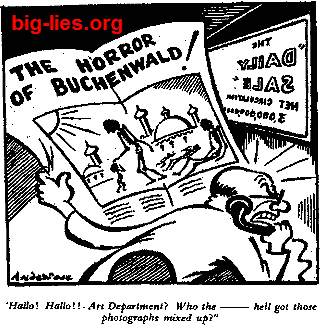
-
- ‘Control experiment’ argument: looking at other cases: What about reparations to China from Japan? What about the Bengal famine? What about reparations to Vietnam? What about 1/2 million dead children and Iraq sanctions? Such cases mean we must assume Nuremberg was almost entirely realpolitik; possibly as much a show trial as Stalin’s ones; perhaps more, since the populations influenced were larger.
- On the little-known Bengal famine, I quote Ray Challinor: “Two to three million were starved in India in 1942. Not because it was a bad harvest; no, it was a good harvest that year. But because all the means of communicating, all the means of bringing the grain to the people, all the trains, were being used by the military in the battles of Imphal and Kohima. So you see keeping the brightest jewel in the imperial crown is more important than the lives of the Indian masses. And this is one of the things which helped to change Indian opinion. ..” (cf Poverty and Famines by Amartya K Sen (1981). Others (e.g. Nigel Harris of London University) say from 1943-1945 ‘between 3 and 5 million died’. A TV film broadcast in the 1997 summer season by Channel 4 in the UK gave an account of how the documents were ordered destroyed by British officials, though their instructions weren’t carried out. Satyajit Ray’s film Distant Thunder deals with this. My personal guess is that some of the mythology of ‘starving millions’ and post-war FAO policy were based on this suppressed event.
Note added in 2015: it’s amusing to note that Amartya Sen married a Rothschild in his late 50s. She is described by Wikipaedia as ‘Jeremy and Jane Knowles Professor of History at Harvard University’. I remember a procession at I think Oxford, including Sen; one has to assume he is an establishment figure, with official views: nobody telling truths about the USSR or Germany! It’s likely his researches into the famine and its multiple causes (Wikipedia lists ‘factors that include British military acquisition, panic buying, hoarding, and price gouging, all connected to the war in the region’) peeped into the doorways of finance, and there are no prizes for guessing how deeply Jewish involvement in ‘World War 2’ was examined by Sen. - Another type of control is to examine fashions in atrocity stories. For example, it used to be stated that people were thrown alive into the crematoria. This is now out of fashion—perhaps because more people have been burnt alive in the twentieth century than in the entire medieval period.
- An earlier event, when concentration camps are often stated to have been invented, was the Boer War in about 1900.
 (Picture © Museum of Boer Republics, Bloemfontein). The point about ‘concentration’ is to gather the ‘enemy’, including women and children, in one place. (This policy was applied in the Vietnam War; Chomsky in The Backroom Boys says this was one of the biggest such events in human history). Such camps—if they are to function—need preserved food, precautions against epidemics and reliable water supplies, which presumably explains their relatively recent invention: they weren’t technically possible earlier. The revisionist Michael Hoffman II puts their invention during the American Civil War.
(Picture © Museum of Boer Republics, Bloemfontein). The point about ‘concentration’ is to gather the ‘enemy’, including women and children, in one place. (This policy was applied in the Vietnam War; Chomsky in The Backroom Boys says this was one of the biggest such events in human history). Such camps—if they are to function—need preserved food, precautions against epidemics and reliable water supplies, which presumably explains their relatively recent invention: they weren’t technically possible earlier. The revisionist Michael Hoffman II puts their invention during the American Civil War. - On laws prohibiting holocaust revisionism, it’s a depressing fact that when it suits legal and other authorities, no attempt is made to prohibit ‘lies about crimes’ when these are ‘acceptable’. Cf. for example the Russell Vietnam Tribunal information, on this site, with (say) a recent BBC series supposedly about the Pacific rim, with Michael Palin, who said nothing about war crimes against the Vietnamese and whose sole qualification seems to be that of an ignorant clown—a qualification undoubtedly thought necessary.
- The French passed a little-noticed law in mid-1998 making denial of the Armenian massacre by Turks—which the Turks apparently themselves deny—an offence. As a result the Turks cancelled a contract with France, I think for arms. Since the Turks were on the German side in the First World War, possibly the event is due for careful reconsideration. I wonder how long it will be before the French role in south east Asia is made legally compulsory to admit? The museum at St Cyr military academy in Brittany still has absurd material on this subject.
- Censorship of Internet? This seems quite likely and no doubt would be accelerated e.g. by a war. And after all, the other mass media are all censored. A good manufactured scare might do the trick—perhaps involving pornography or crime. (An utterly discredited Carnegie-Mellon ‘study’ of on-line pornography was used in a Time feature). On the other hand, the medium resembles the phone system rather than paper/film/radio/TV; so perhaps what will happen will be phone-tapping and regulation, perhaps with an official censor or maybe a board with representatives of major religions and academic organisations. Or perhaps it will be restricted as with radio hams, who have to go through an elaborate licensing system and pass exams in such things as morse code—perhaps web users will be forced to sit exams in (say) IP technology. Or possibly the net will become moribund as with citizens band radio.
Another possibility is increased control over search engines; for example Yahoo! didn’t list the Russell War Crimes site. My entire site vanished from ‘Euroseek’. No doubt there are many similar examples. Another possibility is legal action aimed against piffling errors on websites; naturally, errors and frauds backed by money will reign unchecked.
Yet another is control over intranets in libraries, colleges, companies, military organisations, and so on: my site (including this piece) is barred by ‘Surfwatch’, and also ‘Websense’. The main site (known to me) opposing censorware is Peacefire, who provide downloadable anti-censor software. For some, possibly suspicious, reason, it doesn’t mention Websense anywhere on its site.
I think it’s fair to say that the motivation for Intranets is sharing database and other information, and monitoring of peoples’ work at their desks; the usual explanation, that it’s cheaper to share such equipment as printers, seems untrue, as the cost of printers is low enough that dozens could be bought for the price of a single employee. Peacefire quotes: Fri, 15 Dec 2000. <ALAWASH@alawash.org> American Library Association Washington Office Newsline, Volume 9, Number 100, December 15, 2000. Congress Passes Labor HHS Education Appropriations Bill with Filtering Rider Attached. In a 292 to 60 vote, the House of Representatives has passed the Labor HHS Education Appropriations Bill (HR 4577) with the McCain-Santorum-Istook-Pickering Internet filtering rider attached. … The filtering rider mandates that libraries and schools use valuable resources to install and maintain unreliable Internet filters, or be stripped of key federal funding. With this bill, the federal government has seized control over families and communities and blocked their power to make decisions about the ways they protect their children…. It’s difficult for outsiders to judge this; Matt Giwer emailed to say it’s so far one of tens of thousands of idiot laws we Amircans just ignore until some ACLU type takes it to court.
Of other targets, Internet Service Providers, otherwise known as hosts, are obviously likely targets, and many sites have been thrown off their hosts, sometimes without warning and often, I think, without any refund. Another potential target is phone lines: I’m told a US citizen set up his own host, with dozens of modems, but had his phone line cut off by the local monopoly of Bell. Yet another is the central list of URLs; my domain http://www.big-lies.org vanished for some time from this list before reappearing without my receiving any comment from anyone.
I’ve had a half-joking e-mail from someone, complaining his site hadn’t been barred by anyone. What was he doing wrong?? I’m reminded of an essay by Arthur Koestler in the 1970s, stating that the then-censorship in South Africa had banned his book. Any pornographer can be banned, but essayists have to work harder to receive such accolades, he wrote. - It’s perhaps worth commenting on the First Amendment to the US Constitution (ratified by various states in about 1790, with a few laggards much later). The cynic can’t help but notice that the main effect, now, is to permit large or wealthy organisations to publish any rubbish they want to, with virtually no possibility of redress. I wonder whether the reaction against the French Revolution wasn’t a large part of the motivation for this amendment.
(The motive was to allow post-revolution criticism of British officialdom, according to Matt Giwer and many others). - On secrecy and free speech, I was confirmed in my belief in the lack of any theoretical framework by a lecture by Maurice Frankl, the Director of the Campaign for Freedom of Information, which he appears to run almost single-handedly. His campaign, as far as I could see, consists entirely of ad hoc criticisms and suggestions for reform, with remarks that it’s wonderful in the States.
Hilaire Belloc pinned his faith on the Free Press in his 1918 book. There are some suggestive parallels with websites at the present day. I’ve tried to exhautively list all the scandals Belloc mentions, so readers can decide which changes (Advertising revenue? Subsidies for government line? Legal changes? Electronic publishing?) and scandals (Fed? First World War? Belgian Congo? Lusitania?) were omitted or not known in this detailed review of The Free Press.
Another personal experience of mine has been conversations with people working at the Public Records Office in Kew (‘Fort Ruskin’): I was assured by several people independently that secrecy was important to ensure the privacy of rape victims (the subjects under discussion were the atomic energy authority, and the possibility of the Cold War being collusive). I found one of their functions is to keep secret documents relating to royalty—even in rather remote cases, such as whether hotels should be allowed to style themselves ‘royal’. This organisation is fascinating, having a dual purpose of conservation/curating, combined with time censorship of documents. The name is rather misleading, owing more to P.R. than public record, as many organisations of unquestionable relevance to the public (health, taxes, BBC, money for political parties, covert support for industries) are not required to deposit records there. Its presentation unfortunately is dull and official—and understandably most users only go there to research their ancestors. Their general competence can be judged by their prominent displays about Shakespeare. When I was there, I was amused to hear a history professor say the Americans were keen to leave Vietnam with honour. This is the place from which the records relevant to the Tolstoy legal action and Yugoslavs were removed for the duration of the case. I found that there seems to be no procedure for checking the completeness of incoming sets of documents; anything can be omitted. For example, the Second World War disinformation campaign run by Sefton Delmer (black propaganda on atrocities, and similar subjects; the ‘British’ version of Ilya Ehrenburg) was almost totally destroyed. Interestingly, about sixty years later, British documents on talks during the Second World War relating to peace with Germany are still closed. According to David Irving, many Second World War documents are being seriously damaged by inept researchers. Their in-house Internet has Websense installed, reinforcing the feeling of a total organisation censoring both input and output. The architecture, smoked-glass aquarium megalithic, with irrelevant intrusions, eerily increases this impression. I’m not suggesting this specimen of open government is characteristically British: CIA files on (say) Guatemala being heavily blacked out in the same sort of way.
in Kew (‘Fort Ruskin’): I was assured by several people independently that secrecy was important to ensure the privacy of rape victims (the subjects under discussion were the atomic energy authority, and the possibility of the Cold War being collusive). I found one of their functions is to keep secret documents relating to royalty—even in rather remote cases, such as whether hotels should be allowed to style themselves ‘royal’. This organisation is fascinating, having a dual purpose of conservation/curating, combined with time censorship of documents. The name is rather misleading, owing more to P.R. than public record, as many organisations of unquestionable relevance to the public (health, taxes, BBC, money for political parties, covert support for industries) are not required to deposit records there. Its presentation unfortunately is dull and official—and understandably most users only go there to research their ancestors. Their general competence can be judged by their prominent displays about Shakespeare. When I was there, I was amused to hear a history professor say the Americans were keen to leave Vietnam with honour. This is the place from which the records relevant to the Tolstoy legal action and Yugoslavs were removed for the duration of the case. I found that there seems to be no procedure for checking the completeness of incoming sets of documents; anything can be omitted. For example, the Second World War disinformation campaign run by Sefton Delmer (black propaganda on atrocities, and similar subjects; the ‘British’ version of Ilya Ehrenburg) was almost totally destroyed. Interestingly, about sixty years later, British documents on talks during the Second World War relating to peace with Germany are still closed. According to David Irving, many Second World War documents are being seriously damaged by inept researchers. Their in-house Internet has Websense installed, reinforcing the feeling of a total organisation censoring both input and output. The architecture, smoked-glass aquarium megalithic, with irrelevant intrusions, eerily increases this impression. I’m not suggesting this specimen of open government is characteristically British: CIA files on (say) Guatemala being heavily blacked out in the same sort of way. - War Reporting and Jewish Write-ins: the Arab Image in Western Mass Media [1980] Chap 12: Jonathan Aitken, M.P. p.131: on Israeli commentators ‘Anyone who writes an article for a national newspaper or a talk for the BBC which earns the displeasure of the Israeli Embassy or its allies, can expect to be called to account for it at once. Any complaints about it will be registered at the very highest level, often backed up by a blanket phone-in to the switchboard of the broadcasting company.. (as happened regularly in both the 1967 and 1973 wars). ..’
It’s difficult to judge this sort of thing fairly (there are similar quotations about Catholics), because establishments don’t need to bother with such methods; if they did, they wouldn’t be established. - David Irving writes such things as the Jews being ‘the traditional enemy’ and the ADL being deceitful, and having elaborate spy networks and so on; he doesn’t seem to attempt the controlled experiment approach—thus perhaps the ADL uses the legal and other systems in ways which are unethical, but if many other organisations do so, it’s not exceptional.
- On cyanide: Britain’s Hydrogen Cyanide (Fumigation) Act was passed in 1937, shortly before the Second World War; after the war, cyanide was still used as an insecticide in glasshouses by, for example, rose growers; in the UK it was packaged in small lead containers, I would guess holding (say) sodium cyanide and an acid which would be mixed to generate the gas. This practice fell out of use with the introduction of DDT, which was regarded as a great scientific breakthrough alongside penicillin, but which, like hydrocarbon-based plastics and most synthetic fibres, simply didn’t exist in any quantity before the Second World War.
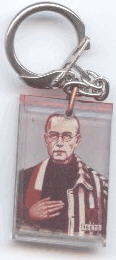 Why go to the trouble..? There are various versions of this argument: why should the Germans have troubled to photograph inmates? (These photos form part of the packs sold to tourists at Auschwitz. The current figure is about half a million tourists per year). Why pack people into trains and despatch them across Europe? For that matter, why use elaborate science? I recall in the late 1970s being told of attacks on blacks by Rhodesians and South Africans; bombs are expensive; just cut their throats.
Why go to the trouble..? There are various versions of this argument: why should the Germans have troubled to photograph inmates? (These photos form part of the packs sold to tourists at Auschwitz. The current figure is about half a million tourists per year). Why pack people into trains and despatch them across Europe? For that matter, why use elaborate science? I recall in the late 1970s being told of attacks on blacks by Rhodesians and South Africans; bombs are expensive; just cut their throats.- The British Imperial War Museum has a copy of a book listing, in English, names and addresses of Britons (Leonard Woolf, H G Wells..) to be eliminated by the Reich. They coyly fail to point out analogous lists of names—for example, Saddam Hussein was reputed to have been provided with just such a list by the CIA, of which he took full advantage.
- Theory of Talmudic exaggeration. This passage is from Butz, partly quoting an archaeologist, Yigael Yadin: ‘The Romans laid siege to Betharin the summer of 135 [AD] and Bar-Kokhba’s resistance collapsed in August. The Romans broke into the fortress and Bar-Kokhba was killed in that final battle. For general reasons it seems unlikely that the Romans carried out a massacre of the Jewish population of Bethar. The only “evidence” for a general massacre occurs in the Talmudic literature (including in this context the Midrash Rabbah) which for reasons unknown comments extensively on the siege of Bethar and its supposed aftermath. .. The Talmud goes on to claim that the number of Jews killed by the Romans after the fortress fell was 4 billion “or as some say” 40 million, while the Midrash Rabbah reports 800 million martyred Jews.’ [However, it’s possible that pre-Arabic number systems, which used letters and were very liable to confusion, enabled these claims to be made, I’d guess – RW].
- Vanunu jailed: perhaps to terrify whistleblowers; or to prevent him discussing his illegal abduction and/or the absurd censorship in Israeli media not to mention nuclear weapons, which is supported by the US which uses Israel to some extent to develop new weapons. This is what many in the ‘Free Vanunu’ campaign maintain. (Info mainly from Frank Barnaby 1996) [Added 2012: it’s now believed by some (including me) that Vanunu was an agent whose job was to pretend to be abducted, and reveal that Israel had nuclear weapons, when in fact they didn’t. See NukeLies.org, the nuclear skeptics forum, preserved in March 2012].
- Leuchter Report : I asked Harold Hillman, who has written and been quoted fairly widely on the effects of different methods of execution, if he might provide expert comment on the version of Leuchter’s report downloadable from Internet. Unfortunately he couldn’t or wouldn’t bring himself to consider this document.
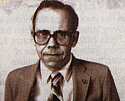 Errol Morris’s film, Dr. Death, The Rise and Fall of Fred A. Leuchter Jr. was shown on UK TV on 15th May 2000. (About 90 mins; it’s known there are at least two versions, but no information was given on its editing. Producers were credited in print as Michael Williams & Dorothy Aufiero. The film itself also listed David Collins. And Jonathan Sehring & John Sloss as ‘executive producers’, which I think means they put up money. The film was ‘produced and directed’ by Morris. I counted over one hundred people in the credits, not counting film stock suppliers etc.).
Errol Morris’s film, Dr. Death, The Rise and Fall of Fred A. Leuchter Jr. was shown on UK TV on 15th May 2000. (About 90 mins; it’s known there are at least two versions, but no information was given on its editing. Producers were credited in print as Michael Williams & Dorothy Aufiero. The film itself also listed David Collins. And Jonathan Sehring & John Sloss as ‘executive producers’, which I think means they put up money. The film was ‘produced and directed’ by Morris. I counted over one hundred people in the credits, not counting film stock suppliers etc.).
I was interested to watch this, as this film has been variously presented as showing a naive and totally innocent man, an unimpressive specimen, a gullible and laughable person, a man seeking comfort in notoriety, an incorruptibly honest man, or just a plain odd person who can therefore be ignored. But as usual (I fear), I found the film virtually useless. Here are my notes:—
- Leuchter, who is or was from Boston, Mass., looks like Rick Moranis. (You know—the little accountant in that film with what’s-her-name). It has to be said he isn’t very photogenic. Someone whose initials are DI told me he looked like Crippen, and had bad teeth from eating junk food.
- A friend of mine said this film’s impressionistic with weird music—it has set-piece studio sequences showing Leuchter doing fascinating things like drinking coffee. I was surprised at how much phoney footage there was, though this seems inevitable with gullible US audiences—four people were credited with helping with ‘reconstructions’, i.e. imitations of such things as Leuchter’s baggy white trousers coming down a hole, stuff being chipped from a wall, water dripping, and so on, all in too sharp focus to have been from the home videos they’d shot at Auschwitz. I have a theory of surrealism—that it surfaces in times when straightforward statement are censored or difficult, for example during the Spanish Civil War—which fits this film. All the people shown, for example Shelly (or Shelley—both spellings used) Shapiro, looked hideous—something to do with the lighting, or enhanced colour, perhaps—I wonder if someone will get revenge with pictures of Morris.
- Ernst Zündel’s 1988 trial in Canada, over the booklet Did Six Million Really Die? (where were its authors?) was the precipitating cause of Leuchter’s look at Auschwitz. Leuchter was the only person Zündel could find in his quest to prove the Germans weren’t a ‘nation of genocidal maniacs’. I was interested to see people indirectly impugning his competence. I wonder how much they knew about circuit diagrams for electric chairs, poison injections, effects and limitations of gas? For example, Leuchter’s comments on electrocution needing two surges of more than 2000 volts seemed properly researched. Luckily, Morris never asked them.
- This film made use of the usual confusion of Auschwitz with Birkenau (see my picture at the top).
Leuchter with his new wife, and a draughtsman, a photographer and I think a few others, went to Auschwitz-Birkenau. Irving called this ‘an act of criminal simplicity’; I think he probably meant ‘criminal’ in the sense of it being a blindingly obvious thing to do, in retrospect. This was February 28th at 10.30 a.m.—Leuchter amateurishly omitting the year, presumably 1988. - I was fascinated to see the chemist James Roth, of a Massachusetts lab, who looked to me just like a well-known person, minus moustache. His analytical technique—he spoke of ‘the test’, while Leuchter specifically said there were ‘several types of test’—involved concentrated sulphuric acid and a red coloration, developed in a flask. (Why didn’t they use a modern analytical technique, with high sensitivity? A mass spectrometer?) The only chemical test I could locate which conformed to Roth’s description is for hydroferrocyanic acid (the sort of thing you’d get in red brick), titrated with potassium permanganate. Since the samples seemed to have been taken from plaster and concrete, the test seemed inappropriate; no wonder they found nothing.
[Notes for the chemically competent: hydrogen cyanide is soluble in water, but gives a very weak acid, weaker than carbonic acid. It’s hard to see why ordinary plaster (calcium sulphate) should absorb any at all. Cement (may contain lime, calcium hydroxide) could absorb it, assuming it hadn’t already converted itself to calcium carbonate by absorption of CO2 from the air; but even if calcium cyanide formed, it seems certain (especially in the windswept, well-ventilated, and wet environment of Krema #2) that over fifty years it would be replaced by calcium carbonate. The ‘dilution’ argument seems rather irrelevant.
The specimens taken, I think all by Leuchter, were of paint samples, plaster, red brick, and concrete from a pillar down which cyanide was supposed to have been sprinkled. (There may have been whitish bricks, or blocks, too). Almost all was chipped from walls, interior and exterior, though he also fished a sample of what looked like brick from the waterlogged floor of Krema II.
It’s important to grasp that hydrogen cyanide gas is unlikely to be ‘absorbed’, any more than coal gas is absorbed. To leave permanent traces, it has to react irreversibly. Red brick plays an important part in debates about gas chambers because it can form—under appropriate conditions—the deep-blue, insoluble ferric ferrocyanide. (Prussian blue. Named after Prussian chemistry, this was ‘originally’ used to make Prussic acid, which is hydrogen cyanide, once the chemistry was understood. The word ‘cyanide’ is formed from the Greek for ‘blue’). Clay in effect contains alumina, silica, and water, with other things including iron oxide. When it’s fired, chemical rearrangements take place leaving hard material. At very high temperatures, the material melts and gives impermeable ‘engineering bricks’. But ordinary red brick is rather permeable to water and gases. Given the right conditions—’the solvent plays an important part in the system’ (Sharpe)—and alkali seems needed—hydrogen cyanide can cause the ferrocyanide complex to form, and Prussian blue (or the ferrous equivalent, Turnbull’s blue) is deposited stably in the brickwork. (Nickel, cobalt, manganese, and some other metals have the same effect. The deep coloration is characteristic of some negative ions—ammonia with a little copper sulphate does something similar).
This is the sort of issue addressed subsequently by Germar Rudolf in his report. The Auschwitz authorities seem to be striking back—though why they should imagine anyone would believe them is a mystery to me. They have lied for years about buildings, excavations in their grounds, numbers of dead, and such matters as soap and skin. Presumably this is one of the effects of continued censorship: as with politicians and military groups and scientists, long-term censorship permits long-term lying.] - There was no mention of the control sample taken by Leuchter from a room (I think of red brick) known to have been used for killing lice by gas, which showed high levels of cyanide.
- Leuchter himself put most stress on the implausibility of the underground buildings as gas chambers:- dangerous, no vents, things which should have been there, but weren’t. The chemistry was a secondary issue. Leuchter’s complete list, as shown in the film, is: no explosion proof area, no leakproof area, no method for heating pellets to evaporate hydrogen cyanide, no pipes, no fan ventilation, and no sealant.
But this was not explored. Morris showed Leuchter being ushered before an audience at the start of a talk; Morris showed an audience listening to the end of a talk. Three or four such bits were shown. Only the middle parts were missing! Nothing was shown of Leuchter’s claimed evidence.
Instead Robert van Pelt had the last word and quite a bit of the voiceover, as though his views were guaranteed to be true. His evidence here was much the same as he produced at the Irving trial, omitting the tricky stuff about crematoria and the ‘no holes, no holocaust’ argument. In addition to drawings, which are often be wrongly called ‘blueprints’, four documents were mentioned, dated 26 Feb 1943, 6 March 1943, 31 March 1943, and 29th Jan (also presumably 1943). On all this, see Irving-v-Lipstadt, days 9, 10, and 11. - The film was edited to emphasise some of the disgusting and unpleasant aspects of Leuchter’s work, and some of the sordidness: “…. execution equipment.. at twenty percent markup.. definitely fair!” Perhaps Morris, presented as a person of great principle, will go on to examine the designers of modern weaponry, including the sort which breaks the Geneva Convention. Plenty of Mr Deaths there! But of course he won’t.
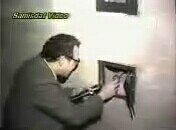 Despite the pretence that the film showed Leuchter’s life, everything that happened to him latterly, after his hire cars were repossessed and so on, went unmentioned.
Despite the pretence that the film showed Leuchter’s life, everything that happened to him latterly, after his hire cars were repossessed and so on, went unmentioned.
I recommend a look at IHR website, where ten ‘real video’ clips on Leuchter (which he pronounces Loosh-ter, by the way) can be downloaded; they total about 40Mb and include many interesting items omitted by Morris’s film, including interviews, press talks and Leuchter’s inspections of Dachau, Mauthausen, and US gas chambers. These are films or videos converted to ‘real’ format. They’ve gone for rather low resolution, presumably to keep the files as short as possible. One of the films shows a talk by Leuchter in Canada, of which only the start and end was shown by Morris. Another shows Ernst Zündel discussing his hiring of Leuchter, and is interesting if you haven’t seen Zündel speak.
- On Kazakhstan: it occurs to me that proponents of a home for Jews might with a slight historical twist have selected Kazakhstan rather than Israel.
Suppression of the Khazar conversion was not solely by the ‘west’. Thus a footnote in Koestler’s book: ‘Artamonov.. published.. his first book, which dealt with the early history of the Khazars, in 1937. His magnum opus, History of the Khazars, was apparently in preparation when Pravda struck. .. the book was published only ten years later – 1962 – carrying a recantation in its final section which amounted to a denial of .. the author’s life-work.’ Earlier than this, Francis Dvornik in The Making of Central and Eastern Europe (1949) says in a note (p. 62): ‘I have treated the history of the Khazars and their conversion to Judaism in detail in my book Les Légendes de Constantin et de Méthode vues de Byzance, Prague (1933), pp. 146-211. An abundant bibliography will also be found there.’ In other words, the Soviet Union suppressed this information, and the Poles knew it all the time, but, perhaps, kept it confined to some academic and foreign-language circles. I don’t know to what extent Polish, Russian etc literature was read by ‘Jews’ or comprehensible to Yiddish-speakers, but it seems likely that both Rabbis and Zionists would have been careful not to transmit such information. There appears to be evidence that the Soviet Union did not wish to relinquish the Khazar territory—their Jewish Autonomous Republic seems to have had a tenuous existence thousands of miles away.
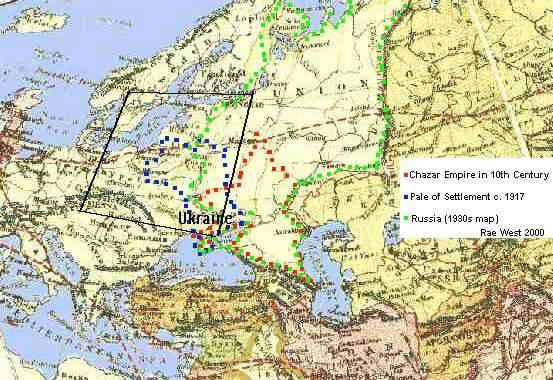 Britton wrote: ‘The modern Jew is descended from a mixture of Asiatic peoples, largely Semitic in origin, but not Hebraic. … The Pale of Settlement extended from the Crimea to the Baltic Sea, encompassing an area half as great as western Europe. By 1917, seven million Jews resided there, comprising perhaps half the world’s total Jewish population. …’ |
- I only recently (Jan 2000) became aware of the existence of Polish revisionist groups. Their view is that the massacre at Babi Yar, a ravine near Kiev, as reported e.g. in Martin Gilbert, was a fraud or hoax (air photography providing their evidence—along with the absence of skeletons); that much of the Jewish population in Poland in fact disguised themselves as Poles (the change-of-name archives being, I’m told, still firmly closed to investigators); that the presentation of Auschwitz/Birkenau, including rebuilt and fake exhibits, relied on concealment and spurious testimony; that Poles were treated just as badly as Jews in the camps; and that the Germans had a system for trying and punishing army war criminals and profiteers. (Other Polish sites are non-Holocaust-revisionist, but put more emphasis on Poles: e.g. Holocaust Forgotten
 ).
).
Another revisionist group examines the Polish corridor, and also Polish military actions before the Second World War. See for example Giwer’s World
People who have followed David Irving’s libel trial will recall that he concedes shootings in eastern Europe on a large scale. This is what he calls the Jewish holocaust. - Historical parallels? If the holocaust story turns out to have been manufactured, are there historical parallels? Witchcraft is an obvious one, used (though of course in the opposite sense) by Trevor-Roper. A book by Norman Cohn, Europe’s Inner Demons.. (1975) has an account of several forgeries in which supposed early cases were manufactured. Unfortunately, although he provides documentation, he’s a dull writer and it’s difficult to extract his point. The Gunpowder Plot, probably rigged up against Catholics, suggests opposite views can co-exist in different groups more or less indefinitely. Forged Catholic documents, however, suggest fakes get found out, but also that such knowledge can remain very narrowly known. A problem with the entire subject is that, after the event, everyone pretends to have had true views all along, so it’s hard to get an accurate picture of the debunking of any myth. An interesting possibility is to try to assess money value of the effects of myths. I’ve heard it stated that the holocaust story generated about $120 billion; I’ve made no attempt to verify this figure, which sounds low. To get this into perspective, the HIV/AIDS fraud based on unvalidated techniques (which, ironically, left diseases of male homosexuals as baffling as before) is supposed to have grossed about $40 billion. In comparison with the ‘Jesus’ fabrication, and the claim of Mohammed’s connection with Allah, these sums are of course microscopic. It would be interesting to compare (for example) the cost of useless construction projects by the World Bank, bogus weapons projects, and bogus scientific research, but I’ll leave these topics for consideration elsewhere.
Modern known-to-be-faked books (e.g. by ‘T Lobsang Rampa’ on Tibet, or Whispering Gallery by Hesketh Pearson (1926), which went to trial to establish Pearson had falsely ascribed the authorship to a retired diplomat) suggest that only authorial confession gives certainty of forgery; if the author’s dead, you can’t quite be sure—cf. remarks below on The Diaries of Anne Frank . Another example is Brides of the Third Reich, submitted by ‘Mrs. L.’ in about 1960 to Secker & Warburg, a lusty story about eugenic breeding by Aryan Germans. ‘Mrs L’ confessed this was a fake; Fredric Warburg stated that ‘Honour had been saved, a potential best-seller was lost.’
But the decline of belief in witchcraft (cf. early with late writings of Thomas Browne), and astrology (no longer taught at Oxford or Cambridge), suggest swings in view can take place more or less autonomously. - The invention of Christianity suggests another parallel; perhaps, since this is little-known, I might expand on this here (and cf. Forgery in Early Christianity by Joseph Wheless, an HTML version of which is on my site.) Thus Gibbon says on the myth of the ‘noble army of martyrs’: (e.g.) ‘The learned Origen, who, from his experience as well as reading, was intimately acquainted with the history of the Christians, declares, in the most express terms, that the number of martyrs was very inconsiderable. His authority would alone be sufficient to annihilate that formidable army of martyrs, whose relics, drawn for the most part from the catacombs of Rome, have replenished so many churches, and whose marvellous achievements have been the subject of so many volumes of Holy Romance. But the general assertion of Origen may be explained and confirmed by the particular testimony of his friend Dionysius, who, in the immense city of Alexandria, and under the rigorous persecution of Decius, reckons only ten men and seven women who suffered for the profession of the Christian name.’
One might view authors such as Martin Gilbert as being in a similar tradition: in the Middle Ages monks laboured over the lives of saints, who, for example, crossed the Irish Sea on gravestones (this example’s from Lytton Strachey). Today, Gilbert labours over Jewish corpses in Poland without skeletons and without burial places. (Norman Finkelstein compared him with J K Rowling, the author of the Harry Potter books). - I found a reference on Internet to a legal action by David Irving against the Board of Deputies of British Jews
- Fascism: Tony Benn: “Fascism was the response of capitalism to the arrival in Moscow in 1917 of socialism. However distorted it later became under Joe Stalin it was seen as a threat—in every form—communism, socialism, social democracy—everything that challenged the capitalist system—the repression of it was supported by western leaders. And in my opinion from 1917 until the Berlin wall came down and still today it is the prime objective of any of the governments representing capitalist societies or believing in capitalist ideas to destroy all forms of socialism, and a readiness to use fascism for that purpose.”
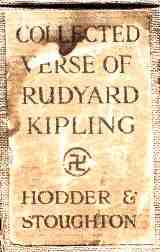 A.J.P. Taylor on derivativeness of the ideas of Fascism, or perhaps more precisely, Nazism. He said (I’m quoting from memory) Social Darwinism was British, Kiplingesque imperialism was British, racism and the white man’s burden was British (and incidentally Kipling’s works were decorated with swastikas), Empire Day and big shows of strength at Spithead were British. Click for a very long, detailed, review of A J P Taylor’s life, and in particular his book The Origins of the Second World War.
A.J.P. Taylor on derivativeness of the ideas of Fascism, or perhaps more precisely, Nazism. He said (I’m quoting from memory) Social Darwinism was British, Kiplingesque imperialism was British, racism and the white man’s burden was British (and incidentally Kipling’s works were decorated with swastikas), Empire Day and big shows of strength at Spithead were British. Click for a very long, detailed, review of A J P Taylor’s life, and in particular his book The Origins of the Second World War.
Baden-Powell’s Scouting for Boys (or a similar publication) had a passage saying the most exciting type of hunting was ‘hunting man’. The ideas of eugenics, racial degeneration and so on certainly existed, or flourished, in Britain and America. An odd similarity is the idea of the rural idyll, the countryside as unspoilt and more genuinely English (or German) than towns. Another odd parallel is the work of J R Green, whose History of the English People in the final quarter of the 19th century popularised the idea of the British as freedom-loving Germanic Anglo-Saxons.
The problem is to exclude things you do, but include them when the others do them. Cp John Pilger speaking on Indonesia, in 1995, ‘by any definition fascist’. - What seems to be a similar view to Hitler was expressed by Stalin—Isaac Deutscher’s biography: ‘Yet while Hitler’s armies were advancing, the Soviet authorities did their best to evacuate the Jews from the threatened areas, even though in some towns—.. Taganrog ..—the Jews, disbelieving the warnings.. refused to budge. With Stalin’s authorization, a Jewish anti-Fascist Committee .. was formed; it called upon the Jews of the West to support the Soviet Union. .. Jews serving in the armed forces fought bravely, … But qua Jews they were not accorded any merit. ..’
591ff: ‘.. [post-War, when demonstrations etc in favour of Israel were forbidden] The Jews were deprived of the right which as a nationality they had hitherto enjoyed; [.. also e.g. theatres, publishers, writers, poets; ‘rootless cosmopolitans’, men of ‘uncertain allegiance’.] It was .. said.. even intended to deport all Jews to Birobidjan, the ‘Autonomous Jewish region’. [However, there were e.g. nuclear physicists and ‘Nearly twenty thousand Jews held teaching posts in the universities’.]
[Note added 24 Sept 2013: the area, territory, location, or whatever of Birobidzhan has been suggested as a suitable location for ‘Jews’ by e.g. Lady Renouf. And possibly there may be plans for it kept in reserve.] - There’s somewhat of a myth of Jewish unity, as there’s somewhat of a myth of ‘English speaking peoples’, at least so far as I’ve observed. In practice Jews in (say) western Europe don’t communicate much with Jews from (say) Eastern Europe; like most people, they look up official-seeming figures in official-seeming books. There’s also somewhat of a myth of Jewish religious awareness, again, so far as I’ve observed. Typical Jews have no idea whether (e.g.) Jews once spoke Aramaic, or whether Hebrews of archaeology were bands of mercenaries, or whether there are racist passages in their religious texts.
- Quote at chapter start from a book by Ian Kershaw on Nazism ‘scarcely capable of rational analysis’ reflects a common attitude.
- Hobsbawm on pogroms: ‘handful of dead of 1881’ and ‘40 to 50 of Kishinev pogrom of 1903’ given in a puzzled way as contrasted with later numbers of deaths. There seem to have been many more killings of strikers in the USA than of Jews in Russia. Hobsbawm seems to have—or pretend to have—no feeling for the reasons for Jewish emigration.
At a lecture (‘Can We Write the History of the Russian Revolution?’ 3rd Dec 1996 at the LSE), Hobsbawm spoke of the early days of the Soviet Union and the ‘establishment of socialism.’ Nobody even laughed. One of the achievements of censorship on this whole complex of topics is that many neutral or desirable things have been smeared. Thus ‘communism’ has been smeared, and ‘socialism’. ‘Democracy’ never quite achieved the same status—not many people believed in ‘peoples’ democracies.’ The good and bad points of ‘nationalism’ are rarely discussed.
[Note added 24 Sept 2013: First of three articles in The Occidental Observer on so-called ‘pogroms’ (May 2012). Recommended as a good overview, with references to Jewish propaganda in the USA and the UK. … Little or no historiography has been dedicated to peeling back the layers of “refugee” stories to uncover what really happened in the Russian Empire in the years before and during the riots. … by Andrew Joyce. 1: Russia’s Jewish Question. 2: Inventing Atrocities. 3: The Jewish Role.
on so-called ‘pogroms’ (May 2012). Recommended as a good overview, with references to Jewish propaganda in the USA and the UK. … Little or no historiography has been dedicated to peeling back the layers of “refugee” stories to uncover what really happened in the Russian Empire in the years before and during the riots. … by Andrew Joyce. 1: Russia’s Jewish Question. 2: Inventing Atrocities. 3: The Jewish Role. - Soap: “In April 1990, Professor Yehuda Bauer of Israel’s Hebrew University, regarded as a leading Holocaust historian, as well as Shmuel Krakowski, archives director of Israel’s Yad v Shem (or Yad Vashem, or Yad’Va’Shem) Holocaust center, confirmed that the human soap story is not true.”
- Note on cremation: at the risk of fogging the issue, I’ve recently been made aware of how little is known on this by revisionists and others. It is possible, under certain rare conditions, for bodies to be largely reduced to ash with minimal external fuel. The book I’ve used is Spontaneous Human Combustion (1992; Bantam paperback 1993) by Jenny Randles and Peter Hough, which has information on cremation practices plus rather absurd material on secret energies, lightning strikes, and so on. What seems to be needed is a small enclosed room with reduced air supply (e.g. under a door) so that flames are kept low, and no draught blows them out; a moderately plump, fully-clothed body; many hours, typically an entire day; and a source of heat, for example an open fire. The so-called ‘slow candle’ effect permits clothing to act as a wick, drawing fat from the victim; after many hours, in which sticky black smoke is given off and the local temperature rises in the upper part of the room, the clothed parts of the victim can be completely reduced to ashes, including the bones, leaving most of the floor and surrounding furniture largely unchanged. (This phenomenon puzzles, or used to puzzle, people; hence the legend of ‘spontaneous combustion’, in, for example, one of Dickens’ novels). But this gruesome process isn’t suited to mass production: a larger room would (I guess) dissipate the heat, so the Dante-esque possibility of a huge, hot, smoky dim room of red glows and ash formed over a few days seems implausible.
- 1919 as first use of the phrase ‘holocaust’, and of the figure six million: The American Hebrew October 31, 1919, article beginning ‘From across the sea six million men and women call to us for help, and eight hundred thousand little children cry for bread. ..’ this is the sort of snippet posted on Internet which is hard to check.
I found in the Jewish Chronicle of 10th Oct 1919, amid articles on the Arab Problem and the Maccabaean Land Company, pp 16-17: Dr Nordau: ‘… The fate of Israel has willed it that the earthly lot of the greater and better half of our people should be thrown in with Russia and Poland. There six millions of Jews, in whom our best hopes of the future were vested, are now existing in unspeakable pangs, threatened with ghastly dangers, too often a prey of bloodthirsty monsters with vaguely human faces, …’ [Thrust of the article is that ‘Palestine must be widely opened to unrestricted Jewish immigration’] - Bullock, Trevor-Roper (Dacre), Hobsbawm, are all rather elderly British male historians with emphatic things to say on the Second World War. These things tend to be descriptive rather than analytical. That is, the ways totalitarianism holds together, and the complicity of the various subgroups, and of external supporters, are not analysed. No attempt seems to be made to identify general principles. Everything is attributed personally to Hitler or Stalin.
- I received some e-mails telling me in effect that there’s no such thing as ‘official history’ and the like. On the contrary; for example, the British education system has a ‘National Curriculum’ in which ‘the holocaust’ is a part. The officials who drew it up might be surprised to be told their work isn’t official.
- Auschwitz.
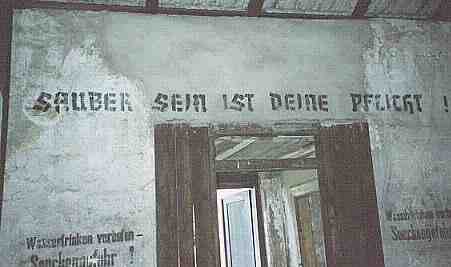
- The message on the wall translates as ‘Keeping yourself clean is your duty’. Messages elsewhere translate ‘One louse, your death’ and the well-known ‘Work Makes You Free’. Ambiguous slogans about clothes, camp hygiene, and so on, to deceive the inmates? Or did they mean what they say?
- Leon Greenman, who seems to have made something of a career as a Birkenau/ Auschwitz/ Monowitz survivor, had an exhibition in the Jewish Museum, in London N3, around 1997, which may still be there. I heard him in 1994; what follows are verbatim extracts, greatly cut down from the original:
“Two days later.. train.. Westerboek camp.. is anybody here that speaks Dutch.. we got out of the train.. several hundreds of us.. old, young and babies.. had to walk 5 kilometres to the camp on a very muddy road.. pouring with rain.. inside to a barrack.. row of typewriters on a table, and behind them a lady or gentleman.. British? Yes, I’m British.. and also American Dutch.. I was born in London and I lived in Holland.. there was a barrack called the English barrack..
. . .
I had to work. I wasn’t an electrician, I wasn’t a farmer.. the German word for getting food out of the kitchen.. milk for the babies, lunch time for the grown ups, the evening meal. .. I did it gladly in my mind I was working for my people, not for the Gerries.
. . .
36 hours and then the train stopped and we heard a loud shouting ‘.. . schnell, schnell, schnell’ leave the train get out as quick as possible. We were half asleep half awake but we got out. .. huge heap of snow.. corners of suitcases.. everything in there will be spoiled. I did not know then that those suitcase were brought by people.. two camps .. Birkenau, one of the greatest extermination camps there was..
. . .
They were told they could have a shower after the long journey, a lovely shower. You undress, you’re told to arrange your clothes neat, place your shoes in a way you can find them when you get out of the bath. You get into the chamber the doors are closed. You wait for water but no water comes. At the top from the ceiling an S.S. usually, even wearing a gas mask throws little pellets down from a tin. That’s Zyklone B. That’s cyanide. And when it drops down it takes 3 to 15 minutes and you’ve coughed yourself to death. That is killing in the gas chamber.
. . .
Well, I stuck two months in Birkenau. .. thousands of men had to.. pass between two tables.. SS men.. you starved.. you were beaten.. what was it like.. if you couldn’t walk properly you .. went left.. if you had some flesh on your bum, you went to the right. .. Auschwitz.. that evening fifteen hundred prisoners marched under heavy guard to Auschwitz.. hard labour.. unloaded out of the trains.. millions of bricks I’ve carried..
. . .
From Auschwitz.. there I lived if you wanna call it 17 months.. the Russians were nearing Auschwitz. We knew the Germans were losing the war.. Auschwitz.. blankets.. they call this.. the death march.. If you couldn’t walk.. you were shot. If you tried to run away, the beautiful white fields, you were shot.
. . .
The journey.. to Buchenwald took five days. I stayed.. you wanta get home, and we all wanna go home, and I don’t wanna be sent to a camp for disobeying order.. four months.. 11th of April 1945 at about 4 o’clock in the afternoon.. I crawled out of my bed and I saw no SS, no SS in the towers, a small aeroplane circling over the camp, dead still.. and then I realised we were liberated. . .” - Auschwitz—Slaves of the Nazi Gas Chambers is another eye-witness effort, a Sky News Production, broadcast in Britain by British Sky Broadcasting on 7 Nov 1999. (Written and produced by Peter Sharp. Directed, photographed and edited by Andrew Barron. Executive Producers Barbara Gibbon, Nick Purnell. &c.)
This showed two brothers and a cousin, now aged 76 to 78, then aged about 18 to 22, Morris Venezia (living in Salonika), Shlomo Venezia (living in Rome), Dario Gabai (living in Beverley Hills), who decide to go back, 55 years later. (I’ve had to guess the spelling of their names).
Voiceovers recounted the story, including the train journey of the three of them from Salonika to Auschwitz/Birkenau, with 65,000 or 54,000 other Jews, the ‘selection’, their jobs as Sonderkommandos, and their return after the 60,000 camp inmates marched and were carried by train to Germany. In fact all the components of the traditional story were there, including tattoos (one showed 182727 on his arm), and an account of being taken aside on the first night and shown a chimney with flames and smoke, apparently from about three storeys up.
Dario was shown, perhaps by mistake, saying ‘the gas chambers, as I understand it’, revealing that he’d never seen one. Morris was shown shoving a sliding part in a crematorium; he seemed vague on its method, and showed no sign of any memories and associations returning to him—I didn’t think it was credible he’d put tens of thousands of bodies in there. It wasn’t made clear why the Germans should have gone to the trouble of moving them back from the Russian advance. (They incidentally murdered a German prisoner on a returning train).
The voice of one of them near the end said “We’re telling the world we’re the only eye-witnesses to the Final Solution.” (I suspect these may have been the Greeks referred to by Professor van Pelt in his testimony at the Irving-v-Lipstadt trial. Wisely, perhaps, he didn’t mention their names or call them as witnesses). - Washington Times June 23rd, 2000, had a story ‘Holocaust story challenged. Jewish group [sic] questions her credibility, accuracy of stories.’ 78-year old Deli Strummer, was probably deported (as Adele Aufrichtig) from Vienna in 1943. She was removed from a list of recommended speakers by the ‘Baltimore Jewish Council’ and/or the Associated Jewish Community Federation of Baltimore’. They supported her for more than twelve years. ‘She also has issued a self-published book and was featured in two documentaries and on video presentations for two holocaust libraries.’ The newspaper report gave a few examples of her implausibilities. One wonders how long it will be before a new comic stereotype, the Jewish liar, will emerge.
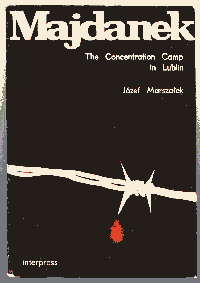 Majdanek. The Concentration Camp in Lublin. Holocaust revisionists can find supporting information in surprising places, such as books like this English-language guidebook sold to tourists. Page 39 states that Karl Koch, after ruling a year in Majdanek, was tried and executed by the Germans. In an extermination camp?
Majdanek. The Concentration Camp in Lublin. Holocaust revisionists can find supporting information in surprising places, such as books like this English-language guidebook sold to tourists. Page 39 states that Karl Koch, after ruling a year in Majdanek, was tried and executed by the Germans. In an extermination camp?- The story of Hugh Trevor-Roper and the fake Hitler diaries is perhaps worth summarising here (these notes were made reasonably accurately from a 1991 TV series of four programmes, based on a book by Robert Harris on the 1983 hoax. I can’t guarantee the truth of the story described.) A rich Hitleriana-obsessed character meets a dealer in his Gothic-lettered ‘Militär-Antiquäriat’ shop, and who says the diaries exist, and are to be put into a piano to be smuggled from east Germany. The dealer says unnamed Americans are also interested. Publishing-house scenes show the decision to keep everything quiet. Rupert Murdoch is represented as out-manoeuvring everybody.
Trevor-Roper or Dacre is shown white-haired, wearing a kilt, acting the part of Scots landowner. (This may itself have been someone’s little joke, as Dacre once wrote a piece on the invention of Scotch pseudo-traditions). There are amusing preliminary scenes: “One of the world’s leading historians.. in British Intelligence during the war..” Invited to Germany for authentication, he announces “Since I read German neither well nor with pleasure, you will have to translate.” A German lies to him, carried away by the situation: “Three handwriting experts have confirmed it, their reports are there.. Forensic tests have been carried out on the paper, ahem.” In fact, the latter part wasn’t true; they were about to be carried out. Trevor-Roper responds: “There’s an immense amount of material.. Goering himself told me Hitler made a noise, an ‘animal-like noise’, that’s how he put it.. I cannot see that anyone would go to so much trouble.. yes, I believe they are authentic.”
Amusing scenes follow where historians are pleased that their pet theories are ‘justified’: for example, on the Munich conference, the diaries talk of ‘that cunning fox Chamberlain.. we will invade Czechoslovakia on [date], just as I have always planned.’ A US man sits up at this, and says in effect that confirms his theory.
Later, Trevor-Roper is shown as developing doubts, as, for example, passages reminiscent of book extracts occur to him. The clinching evidence appears to have been forensic: the books were from post-war Woolworth, the red seals made of plastic from Hong Kong.
This limerick (roughly) was offered as an undergraduate product:—
A certain old Fellow named Dacre
Though God in his own little acre
In the matter of diaries
Was quite ultra vires,
And unable to spot an old faker.
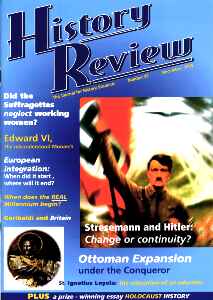 Illustration: cover of Dec 1999 History Review, ‘The Journal for History Students’, which lists Dacre along with thirty other ‘Academic Advisers’. It includes a prize essay, Poland and Holocaust History, by a schoolgirl, who gives little in the way of sources—despite the lip-service paid in history teaching to documentary evidence. (Other pieces include one subtitled ‘Loyola underwent several forms of education himself before setting the Jesuits on their educational mission’, another beginning ‘Able and intelligent though the boy [Edward VI, aged 9] was..’, and a third on the Historical Association’s worries about ‘over-concentration on Hitler and the other twentieth-century dictators.’)
Illustration: cover of Dec 1999 History Review, ‘The Journal for History Students’, which lists Dacre along with thirty other ‘Academic Advisers’. It includes a prize essay, Poland and Holocaust History, by a schoolgirl, who gives little in the way of sources—despite the lip-service paid in history teaching to documentary evidence. (Other pieces include one subtitled ‘Loyola underwent several forms of education himself before setting the Jesuits on their educational mission’, another beginning ‘Able and intelligent though the boy [Edward VI, aged 9] was..’, and a third on the Historical Association’s worries about ‘over-concentration on Hitler and the other twentieth-century dictators.’)
- On the current media generally, and extending out of the field of holocaust revisionism, my notes reveal the following:
- BBC, Tues 9th Feb, 1999. On Bletchley Park decoding centre. (Series producer David Darlow/ producer Peter Bate). Germany was the ‘most evil empire ever known’ and ‘death camps’ There were interviews with people who’d worked at Bletchley Park (including Roy Jenkins, a one-time Home Secretary. If I recall correctly, he permitted a Vietnamese war criminal to come to live in Britain). Some said things like “You can defeat an enemy intellectually”—apparently without military superiority. The fact that the capture of an Enigma machine was absolutely essential was glossed over; the supposedly brilliant linguists and mathematicians could have done nothing without that. (They did at least have the honesty not to pretend that computers were vitally important). The absence of decoded information on extermination was glossed over and interpreted in the distorted conventional sense. All this is particularly contemptible because such a program costs something like $400,000, and many of the people involved will be dead before anyone re-interviews them.
- Journey to the Far Right (Sat 20 March 1999. Written/presented by Nick Fraser, a bald, thug-like person), another BBC production, almost two hours long, contained unspecific material on the ‘right’. Naturally nothing was said of war crimes in the ‘third world’.
- Fri 9th April 1999: Brian Walden on Hitler. (BBC, half hour). Walden is one of these characters with no very obvious abilities who perhaps reads autocues well, or something. His delivery is enlivened by a heavy lisp. Hitler was a “bwootal tyrant.. woofless aggressors.. his crimes of genocide and aggression continue to appal.. Wemember that this is the man that polled more votes than.. any other German leader.. his thought was depraved and vicious.. the greatest propagandist of the century.. a social Darwinist.. war the most natural of human activities..” None of this was backed by evidence.
- Too numerous to list are programmes in which awkward facts are elided over. Typical is the fact it’s never made clear that Britain declared war on Germany, in both world wars. The formulations are typically: “When it became clear that Hitler wanted war..” or “hostilities commenced on..” or “when war broke out..”. What a useful phrase ‘broke out’ is! As though a huge war just happens, like catching a cold. Wernher von Braun ‘found himself’ working for the US illustrates the same sort of thing.
- Miscellaneous propaganda:
- I was amused to find this in British Archaeology , June 2000: ‘Few wartime discoveries ..proved.. as dramatic or far-reaching as the chance finds made by RAF engineers.. in North Wales in 1942. .. among the heaps of peat they noticed iron weapons and chains. .. the director of the National Museum of Wales, Sir Cyril Fox, .. visited.. The Times published a short report.. in 1944. .. swords, spears, chariot fittings.. animal bones.. slave chains.. Other votive sites .. discovered since.. have invariably yielded human remains. [I.e. bones, ‘presumably the evidence of human sacrifice’.] .. a researcher thinks that Fox may have deliberately overlooked the bones, for reasons of wartime propaganda. .. Fox may have been reluctant to publish evidence of ancient British sacrifice, as it was incompatible with wartime notions of British decency and fair play. This propaganda conveniently contrasted with the cruel sacrificial killings and executions that Tacitus, the Roman historian, reports of the ancient Germans. ..’
- Alfred North Whitehead, who moved to the US before the Second World War, described the Germans as people who ‘like to knock things down’. He managed to make the front page of Time , as I recall, on the strength of this sort of thing. An opposing view is presented (for English readers) by McCabe on my site: Germanic tribes made about four notable efforts at civilisations, all of which were destroyed, usually by Catholic powers.
- [From www.author.co.uk, June 2000:] ‘… a week when a new film (movie) is sweeping the US, U521 (he thinks that’s right) is a blatant deceit alleging that the American navy took the Enigma machine from the Germans, when it was a British submarine that was really involved, and the event took place when the Americans were not even in the war. Now the American movie makers are to rewrite the history of Colditz as well. I don’t wish to condemn the entire US population for the greed of a few of the film makers but it does reveal the need for .. objectivity …’
- Museums.

The illustrations show a tiny museum in Berlin, ‘Das Anti-Kriegs-Museum’, set up by Ernst Friedrich in 1925. It was closed in 1933. The right-hand illustration shows part of a display relating to the First World War. (From a booklet by Tommy Spree). It’s interesting to speculate on other anti-war museums: certainly I have never heard of any, in any other country. Apart from a museum of wartime atrocities, in Vietnam—which they were forced to close in order to receive ‘aid’.
The Imperial War Museum (London) opened a ‘holocaust’ exhibit, accompanied by advertising; it had a similar exhibition previously (London blitzed—ration cards, gas masks etc) and this is an enlarged version. It is of course be a fraud: real genocides need not apply to be noticed. (Opening day was Tuesday 6th June 2000; the Queen was instructed to attend).
I once spoke to the historian in charge of this museum, who turned out to have a PhD—based on work on the Domesday Book. As in other divisions of the media world, the important thing is to employ people with little grasp of the subject.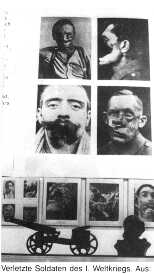
- The first state to officially adopt the view of a fake ‘Holocaust’ may have been Syria. Monday Jan 31st 2000 edition of Teshreen (it has an Arabic website, www.teshreen.com; there are transcription variants) ran a piece by editor M K al-Wadi, presumably in Arabic, saying something like Israel & Zionism want to make more money from, and accuse of anti-Semitism opponents of, the myth of the holocaust and the erasure of fifty-million-odd total victims (and more recent Arab victims). At least, this is according to Reuters: this announcement may have more to do with money, the Golan Heights, and such things, since there are earlier similar statements, e.g. Nov 7 1998 Damascus Radio (according to an ADL website) ‘.. many legitimate doubts concerning everything connected with the myth of the Nazi ovens.. Many authors.. have concluded that all the stories.. were exaggerated and fabricated..’
- ‘… Not as bad as Hitler.’
There were many forces tending to cause ‘the Holocaust’ to be accepted. Without trying to be exhaustive: - It helped minimise atrocities, both during the Second World War and, with the expansion of American power, after the War, for example, in Korea and Vietnam. (In Korea it helped with the invention of the myth of ‘brainwashing’). Other examples include Henry Kissinger, a mass murderer who (I recall reading years ago in a British Sunday colour supplement) said his relatives ‘were soap.’ In April 1999, I saw a headline in a London Jewish newspaper: ‘Kosovo: Rabbi says no holocaust’ or something very similar.
- It helped justify research into genocidal technologies (most of course was and is secret);
- It was probably made up to help create Israel, but this can’t have been the only reason, since many of the participants wouldn’t have had that motive.
- The Allies liked it, including the French, because it demonised the Germans and justified, after the event, their alliance with Stalin;
- It permitted maltreatment of Germans. (James Bacque’s 1997 Crimes and Mercies: The Fate of German Civilians Under Allied Occupation, 1944-1950 , based on KGB archives, which were opened after his earlier book Other Losses , gives details, though his figures are hard to interpret because, like the deaths after the First World War attributed to influenza, many might have occurred anyway under the circumstances.)
- The Poles and the Russians liked it, partly because it made Stalin look better;
-
- Dispassionate and truthful discussion of Jewish roles in wars and atrocities was made difficult (read for example Michael Hoffman II‘s piece
 );
); - It made reconsideration the war seem unnecessary. Obviously, it must have been a good thing;
- Churchill liked it: Ben Pimlott wrote that Churchill had been regarded as an adventurer, and seen as a defender of freedom only by coincidence, his ‘firmness’ a joke until 1941. Keynes wrote on Churchill in 1925 intensifying unemployment; later, Britain ‘helped to save the world’;
- There must have been some eye on the possibilities of revolutions (the pattern of the First World War might have repeated). So a base in oil regions (and also strategically placed for Suez) must have seemed useful to some, though of course there was ambivalence over this;
- There was and probably still is a lingering feeling that modern ‘Jews’ have some sacrosanct Biblical connection;
- Cheap paperbacks, magazines, newspapers, and the new medium of TV (and their readers) liked the stories;
- It justified appropriation of technologies—electron microscopes, sewage technologies, and rocketry were some of the products harvested from Germany.
- Dispassionate and truthful discussion of Jewish roles in wars and atrocities was made difficult (read for example Michael Hoffman II‘s piece
[Back to start of ‘Free Speech, Internet, & Holocaust Revisionism’]
2012 – FIFTEEN YEARS LATER 
[Back to start of ‘Free Speech, Internet, & Holocaust Revisionism’]
-
- The Korherr Report and Hermann Höfle intercept relating to the so-called Reinhardt Camps have occupied David Irving since about 2002. The first document found (see 2011 material on Reinhart camps for details of both) contained ‘anomalies’:
… the Höfle document bristles with anomalies and even mis-spellings (and bad math). Wartime German signals, particularly those sent by cypher, had to conform with very strict layouts, norms, content, and style laid down by military directives, Intelligence, SigInt and civil service, and this item is significantly delinquent in half a dozen or more respects. Moreover, it mentions Adolf Eichmann, of all people. It is of high security classification, Geheime Reichssache, and I cannot recall having found more than half a dozen of these rare signals in the entire archive. It does not give a proper reference subject (“Reference: radio telegram therefrom”), because it does not risk offering a Registry-number or even a date of the radio telegram (“Fs.”) it is purportedly answering, and much else. And it has been glued into the volume out of page-sequence.
About ten years later another relevant document was found at Kew. (The three documents contain a common total). In view of what’s been discovered about Jewish frauds in the same time period over 9/11 (not to mention innumerable financial, war-promoting, and science frauds—and the fact that the Public Records Office at Kew was headed by a Jew) I know where I’d place my bets.
- Move down for my pictures-and-biog survey of fifteen years 1997-2012; Anglo-American point of view.
- As regards Internet– email, chatrooms, Microsoft Office, eBay, Amazon and Google were established when my 1997 piece was written. Digital TV enabled 9/11 TV footage to be saved in the USA, very probably something not anticipated by the 9/11 planners. (Britain was slower; the BBC’s 9/11 issue of Question Time, where the BBC wrongly decided which lies to peddle, seems to have completely vanished). Bulletin boards and large forums had a peak launch year of about 2000. Content management systems followed—such as WordPress (2003) & Joomla (2005)— allowing ‘weblogs’ and the ‘blogosphere’ to blossom. Faster data transmission rates allowed Youtube (founded 2005). IntenseDebate and Disqus (both 2007) enabled comments to be logged.
[Not considered here… Underlying the consumer electronics, there was a continuous process of hardware development (faster chipsets etc), software development (new high-level languages), hole-in-the-wall cash machines, readable cards, barcodes, intranets, image and sound processing, and secret military applications and associated frauds.] - When this piece was uploaded ‘9/11’ was four years into the future. As that story has evolved, with its shameless attempt to shift the blame onto Muslims, the similarities between Jews and Muslims have become more noticeable. For connoisseurs of spin, the attempt to hide this fact is also noticeable; see for example Caroline Cox & John Marks on Islamism.
At the time of uploading, I had no idea the ‘moon landings’ were fake, along with a lot of supposed space science, though I knew ‘AIDS’, BSE, much of theoretical biology and much of modern physics, and many other things were laced with frauds. The nuclear scepticism issues were more than ten years ahead, at least as far as my awareness went.
In Britain in 1999, the Report of the Stephen Lawrence Enquiry was published, part of the Jewish move against the British police and people. Conway’s book A Nation of Immigrants? is a small part of the fightback. - Specifically on the ‘Holocaust’™, the official view remains the same, largely because of Jewish control of the media. However, digital movie cameras, editing software, and broadband have all become far cheaper. Recently, devices such as the ‘Kindle’ have made downloaded computer material easier to read. One-Third of the Holocaust is an example of a very well-planned and documented video, still, perhaps, on Youtube, after many removals. Videos must have eroded the official line. And free blog and forum software packages (WordPress, Joomla, phpBB, …) have allowed vast numbers of written and illustrated blogs to flourish. So far, the forces that want to suppress free speech haven’t had things all their own way.
- I find it impossible to form an opinion on the penetration of revisionist views in the general population. This sort of thing (see box)
 is still fairly typical. I have plenty of examples of rather ludicrous ignorance, but I won’t bore the reader with them.
is still fairly typical. I have plenty of examples of rather ludicrous ignorance, but I won’t bore the reader with them.
It’s curious that ‘Mensa’, supposedly a high-IQ society, is full of very ignorant people—I was myself banned by someone called Geoff Theasby, from one of their junk email comment sites, who was not in any way an elected, or other, official in Mensa.
Despite the diffusion of incredibly good technology, the ‘natural indolence of mankind’ remains. No blogs (that I know of) store their topics and debates in a searchable form—the comments are stored separately, so full topics can’t be searched. The commenters usually form tiny cliques. There are innumerable people who post links to sites and videos without bothering to explain what they’re about. CODOH seems to have never tried email promotional campaigns (only a few months ago they were discussing leaflets under car windscreen wipers!) I doubt if there’s anyone in Britain who makes notes, for future reference, on BBC daily news headlines. There are anecdotes about black crime, corrupt policing, vote rigging, covert support of drug dealing, but few sites write these things up in an accessible manner. Hardly anybody is informed on quantities—borrowing, immigration figures, unemployment statistics, money spent on law or oil or weaponry. I don’t know any site which explores the frauds made possible by paper money. I recently noticed Martin Webster’s claim to have known Jewish policy was to promote immigration into Britain since the early 1970s, and yet this is news to almost everyone, despite for example a 1969 ‘report’ Colour and Citizenship with its absurdly ignorant emphasis on ‘colour’.
‘Holocaust’-related sites remain therefore much as they were in 1997, except that further information has been allowed to emerge. - Here’s my quite long and detailed new-in-October-2103 review of Mein Kampf, prompted by a copy I happened to find. The only book, so far, dealing with Jewish money and politics, that has been fairly widely printed and translated, though in many parts of the world it was, and is, banned. [Note added Nov 1 2013]
-
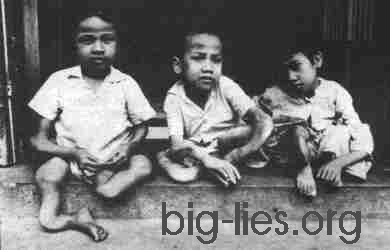
‘Operation Ranch Hand’ was a US chemical warfare spraying policy. Resulting in deformities, ascribed to ‘Agent Orange’ (though this may of course be a typical untruth). How much of this was a Jewish operation has never been investigated, as far as I know. Chemistry textbooks often (or always?) omit this. It’s possible the Internet material on ‘chemtrails’ is disinformation on this topic.The astonishing ignorance and moral imbecility of the western military and intelligence continues—’military honor’ is as dead as the dodo. I have to hand a copy of Richard Dannatt’s Autobiography (2010) (just one example) and it’s clear he has no idea about the history of eastern Europe, the spurious claims of the ‘Holocaust’, the mass killings in the USSR and ‘Holodomor’. He is unaware of Jewish influence in Ireland. There is no mention of Scarlett, who rigged up the fake documents needed to invade Iraq. There’s no mention of nuclear weapons at all—it’s impossible to assess his information on this point. He has no serious knowledge of 9/11. Or of the paper money/dollar problems. Point these people at ‘the enemy’, and off they go to ‘do the right thing’. Some of them—sending drones to kill remotely—complain at assassination attempts. The only saving grace is that some of these people have pragmatic common sense, and are willing to meet and talk and argue—an attitude notably absent from the ‘chosen people’.
- The Korherr Report and Hermann Höfle intercept relating to the so-called Reinhardt Camps have occupied David Irving since about 2002. The first document found (see 2011 material on Reinhart camps for details of both) contained ‘anomalies’:
- My impression is that sites looking at general Jewish influence have multiplied: here’s my survey, mostly of the 20th century. ‘ZOG’ is a widely-recognised term; so is the ‘Frankfurt School’. The revisionist process is extending back in time—the ‘Cold War’, Vietnam, Korea, Cuba, the Second World War (including Vichy France, the ‘Nazi-Soviet Pact’, Hitler, Poland), the Spanish Civil War, Ukraine, First World War (Wilson, Bernard Baruch, Balfour Declaration), the US Civil War, both opium wars, 1848 in Europe, Napoleon and the ‘French Revolution’, and back through the Renaissance and Reformation to the expulsion of Jews and beyond. New topics, notably 9/11 and nuclear issues, have emerged, along with reconsideration of such events as the ‘Great Depression’, Jews in the USSR, specific groups of Jews (for example from Hungary – Bela Kun, Edward Teller, Ulam, Schoenman, Rotblat, Arthur Koestler, Soros, Sarkozy …), and post-1945 laws on immigration, race, crime and punishment (see review of Hanged by the Neck), marriage, abortion, education, and churches, the ‘European Union’, the IRA, and the underlying concealed social engineering. More people than ever are aware of such issues as AIPAC and the ‘mainstream’ political parties being heavily Jewish-controlled.
Partly by contrast with Internet, mass media and entertainment are more understood than before. See these not too serious reviews of a James Bond film with nuclear stuff, a John le Carre spy thriller which of course says nothing about Jewish influence on science, and The Midwich Cuckoos, a 1950s British mind-control science fiction story. The progress of revisionism backward in time has been helped by DVDs of old films; here’s a review of a low-budget film The Intruder made just before JFK’s murder. - Anti-revisionism, plus taxpayers’ money, plus unemployment, has encouraged the proliferation of irrational propagandist websites. For the connoisseur, here’s some information on exit strategies which try to escape the tricky situations which have been allowed to develop. Whether these strategies will work or not I simply have no idea—past insistence that ‘It must never happen again’ may prove a double-edged weapon, since ‘never forgive, never forget’ will probably be applied to Jews in the USSR.
And we have Fusion Centers (’18-20 year old military operatives in the UK, US and Israel’); Fake Skeptics sites, such as James Randi’s ‘Educational Foundation’ (deals only in soft targets such as telepathy, dowsing, etc); Trolls, and entire sites set up as disinformation—here’s a long-established example from the nuclear world. The general media, and organisations such as the NUJ and NUS, are of course a ubiquitous part of the problem. Teachers, historians, taxpayer-funded fake charities and think-tanks all peddle the same line. Women remain uninformed— here’s the Protestor’s Handbook. The laziness and mental inertia of great masses of people is disappointing, but has to be faced. I’ve seen very recent email comments saying ‘walking on the moon is the greatest achievement of the white race’! - This talk coincided with the start of ten years of Tony Blair, in which the Jewish policy of racially-mixed immigration into white countries was stepped up. Kevin MacDonald’s books are a landmark, identifying Jewish policies as well-established facts in the social sciences. Perhaps organisations will be set up to study Jewish influence. (There are at least two weaknesses in MacDonald’s approach: one is lack of science revisionism, the other is accepting the Jewish media line suppressing war crimes by whites). The legal system’s financing—both legal aid, and vast amounts given to agencies such as the EHRC—ensured ever-increasing Frankfurt-School style interventions; see e.g. Cherie Blair’s Autobiography. The BBC rigidly peddles the official line: the ‘horrifyingly shallow’ Greg Dyke was replaced by the sneering Thompson, who left for the ‘Jew York Times’, though my guess is he will make no impression. The BBC publishes many books—here’s a hostile review of one by a supposed economics correspondent Maurice Peston
- Meanwhile, it’s clear the European Union is modelled on the USSR, and is rigidly undemocratic, and was secretly designed to be that way. The earlier, 20th-century model, of Freemasonry as a control mechanism of Jewish currency (and in Britain possibly royalty), has given way to Common Purpose, a semi-secret organisation encouraging town planners, builders, bureaucrats, healthcare people, financiers, charity and foreign aid businesses, and agencies to co-operate secretly, under ‘Chatham House Rules’. Presumably this follows the switch from many genuine businesses to bureaucracies.
Fifteen Years 1997-2012 – Picture & Caption Reminder
|
|
|
|
|
|
|
|
|
|
|
|
|
|
|
|
|
|
|
|
|
|
|
|
|
|
|
RIP: John Smith 1994; Diana Spencer 1997; David Kelly 2003; Robin Cook 2005
[Back to start of ‘Free Speech, Internet, & Holocaust Revisionism’]
SOURCES
[Back to start of ‘Free Speech, Internet, & Holocaust Revisionism’]
- International War Crimes Tribunal on Vietnam , founded by Bertrand Russell, is on this site in One file. (There is more archived material in total than here).
- New York Times: I’m not of course intending to imply the New York Times is a reliable source. In fact it systematically suppressed information (for example) on the Vietnam War as a deliberate matter of policy.
- [Added 24 Sept 2013: I recorded a number of talks on a number of issues, mostly in London. Some are on this site. See audio and video list. Live speakers include Tariq Ali, Tony Benn, Hermann Bondi, Alan Bullock, Peter Cadogan, Noam Chomsky, Martin Gilbert, Leon Greenman, Christopher Hitchens, Eric Hobsbawm, David Irving, John Pilger, Stephen Rose, Justin Rosenberg.]
- Christopher Hitchens: talk in Nov 1995 on a panel discussing ‘Radical Journalism’, celebrating the 25th anniversary of Verso , the publishers. Hitchens works (I think) at the New School for Social Research in New York; I taped a recent radio talk by him, which makes it clear that he isn’t willing to face the problems raised by revisionism.
- John Pilger in a talk ‘The Hidden Power of the Media’ July 1996 ‘Marxism’ series of meetings in London.
- ‘Computers Don’t Bite’ was a typically foolish BBC sequence of programmes—I think intermittently lasting one week—hosted by people knowing nothing.
- George V quotation from Edgar Wilson’s The Myth of the British Monarchy .
- South Place Ethical Society publishes their (mostly Sunday) talks in what’s now the ‘Ethical Record.’ They also publish their annual ‘Conway Memorial Lecture’, held in honour of Moncure Conway. I’m almost certain they have never dealt with the issue of money and churches.
- Noam Chomsky on John Milton’s Areopagitica is in Deterring Democracy —quoting John Illo, May 1988, in an interesting passage on John Locke and others.
- J S Mill and Queen Victoria; I’m paraphrasing Bertrand Russell in Power .
- The 6th edn Concise Oxford Dictionary says of revisionism: ‘Policy of revision or modification, esp. of Marxist-Leninist doctrine’ but gives a purely English etymology as REVISION + ISM. However, the word was first used before Lenin. Another example of its use is Jabotinsky’s ‘revisionist Zionist’ group formed in 1935 (this information in e.g. Encarta 95 .) Later, Chinese party members accused the Russians of ‘revisionism’.
- On censors cutting out anything tricky: Paul Foot of the SWP in a speech just before the Iraq War said the first item on a list of things not to be published was ships burning. This was an issue from the Falklands.
- Arab world press: I have to confess this statement is from a Penguin book, Essential Arabic .
- Stationers Company: this observation quoted from Peter Cadogan; probably I’d guess he took it from Christopher Hill.
- Dutch liberalism and printers: the money aspect struck me when examining a collection of manuscripts and printed books, some of which were Dutch, in Lincoln Cathedral.
- G B Shaw listening to the radio: this is taken from a late 1940s (undated) book by S Winsten.
- Lenin: ‘Marxism and Revision’ published in 1908, according to a copy of Selected Works which I have. I’m not sure which language it was written in; possibly the slightly wrong flavour of the word ‘revision’ comes from an unfortunate translation. Perhaps it’s supposed to mean looking again. I recall a joke made about the less-industrious students before exams: what they were doing wasn’t ‘revision’, it was just ‘vision’.
- On such issues as trade deals with Germany and shareholders’ money and the Basle bank for international settlements, the only accessible sources seem to be (for example) Independent Labour Party publications.
- Benn on the 1930s and support for Hitler is taken verbatim from a talk Keep the Media Nazi Free in 1994. [Note added Oct 2013: this was part of the move to censor out any discussion related to Jews, the Second World War, the ‘Holocaust’ fraud, and corruption from the media—it became NUJ (‘National Union of Journalists’) written policy for example never to report accurately on organisations such as the BNP.
- A minor novel of the 1930s, exploited by Jewish film industry for its propaganda, was Christopher Isherwood’s Mr Norris Changes Trains. Here’s an accurate hostile review: A Curiosity of Propaganda by a Sad Little Poof [Note added Sept 2013]
- Robert Blake from Illustrated London News special edition of 1989; his article amid monochrome pictures, old adverts, and unenlightening old editorial matter.
- Gabriel Kolko so far as I know was one of the first US historians of a revisionist type. D.F. Fleming of the two-volume The Cold War and its Origins was another.
- Merchant seamen: this is a blurb from the Radio Times (BBC magazine) 1994:—‘One in four British seamen died during the Second World War. Life on board ship was dangerous, poorly paid and carried a far higher casualty rate than any of the armed services. Yet their bravery and sacrifices have barely been recognised… faced the North Atlantic storms and the deadly U-boat menace to keep Britain supplied..’
- Felderer, Faurisson, Irving, Rassinier, Zündel etc: the information here comes almost entirely from Internet sources, both pro- and against. Few of these people have their own sites; Butz was the only one until David Irving, previously downloadable from the CODOH site, established his huge site http://www.fpp.co.uk, ‘Focal Point Publications’. Similarly there seem to be no sui generis anti-revisionist sites: almost all are specially set up. I originally gave very few Internet site URLs (addresses), as they may have changed, but this has happened less than I’d expected—so see below for my list.
- On David Irving being somewhat looked down upon for his prolonged belief in the holocaust, I base this remark on Faurisson’s testimony in 1988 in the second ‘Zundeltrial’.
- Noam Chomsky’s ‘foreword’ to Faurisson (in fact a piece entitled Some Elementary Comments on the Rights of Freedom of Expression) is in the Chomsky Archives on Internet. There’s a visual account in the Canadian film, dated 1992, Manufacturing Consent, in which Faurisson is shown at a French café with the Eiffel Tower in the background.
- The Gayssot-Fabius law, or Sirat-Fabius-Gayssot law: the wording here is taken from a 1994 Internet article by Frank Miele in The Skeptic called Giving the Devil his Due.
- Did Six Million Really Die? is available on the Zündelsite (see below). The authorship still seems uncertain.
- On Colin Wilson in Books and Bookmen, no Internet source seems to give any detail of the controversy which followed. My guess is that there was more heat than light. [Added Oct 2013: here’s a talk by Colin Wilson with almost no Jewish references, however.]
- The only reference I can recall in ordinary writings to ‘Did Six Million..’ is in Neil Lyndon’s No More Sex War , (1994), a critique of feminism. From memory, he says something on the lines of “what does it matter if it was six million or one million?”
- Russell Burton (of Purnell’s History of the Second World War) gave testimony in the second Zundeltrial, which therefore is readable on Internet.
- Koestler’s Thirteenth Tribe seems to have been removed from Radio Islam’s Website, perhaps because of copyright infringement, since his death is well within the periods of lapse of copyright. The book review sent to me was in Congress Monthly of Jan 1977, by Harold Ticktin. Much of the review is irrelevant to the points made by Koestler’s book.
- Francis Dvornik ( The Making of Central and Eastern Europe, 1949, published by ‘The Polish Research Centre Ltd, London’) may be a Catholic-funded post-war volume; or it may not.
- Norman Cohn’s book Warrant for Genocide is subtitled ‘The Myth of the Jewish World Conspiracy and the Protocols of the Elders of Zion’ which more accurately represents its very narrow content.
- Martin J. Walker’s Dirty Medicine , (1993 1st publn. Walker is hoping to reprint), though marred by the currently almost universal failure to grasp the flaws in modern biology is interesting, though Britain-centered and legally mauled.
- On the magazine Searchlight , one of the few references I’ve ever seen was enormous graffiti on a wall in Conway Hall, SEARCHLIGHT = MI5. (NB: I submit this as perhaps the first reference ever made to graffiti as a source in a serious article).
- Johann-Paul Kremer, J P Kremer, Johannes Paul Kramer: like Höss, the subject of much remark and counter-remark on Internet. Not to be confused (I presume) with Tibere Kremer. J-P Kramer is always linked with Nyszli and Auschwitz.
- On Deborah Lipstadt’s Denying the Holocaust: the Growing Assault on Truth and Memory, a 1994 review (by Brian Siano) states: “The readers of Skeptic may be disappointed when they find that Lipstadt has substantially avoided the second front, which is a detailed refutation of their actual claims.” (The ‘first front’ “is in “opposition research,” i.e., outlining their institutional affiliations and political agendas and goals.”)
- The Scourge of the Swastika, A Short History of Nazi War Crimes (1954) went through huge numbers of reprints. Most of its text is unreferenced though clearly largely based on Nuremberg transcripts. Its Epilogue refers to Dachau and its gas chamber with peep-hole, adjacent crematorium, little room for bodies and ‘machine for grinding bones’.
Compare this with (from ‘Radio Islam’): ‘In August 1960, the Munich Institut fur Zeitgeschichte made the following declaration to the press: “The Dachau gas chambers were never finished or put in action… Mass extermination of Jews by gas began in 1941-42, and only in a few places in occupied Poland, by means of technical installations set up for that purpose, but in no cases on German soil.”
Russell [not Bertrand Russell] also wrote a book on Japanese war crimes, and an introduction to the 1959 translation Commandant in Auschwitz , and - Note that Internet sites have sourced critical comments on Simon Wiesenthal of an extraordinary nature: I quote one, for the sake of definiteness: Jerusalem Post of May 18th 1991, J Schachter, ‘Wiesenthal had no role in Eichmann Capture.’ This, supposedly or in reality, (I haven’t checked) reports Isser Harel, once head of Mossad and Shin Bet. David Irving disputes this and implies Wiesenthal, Harel and others had fallen out over what to do about Kurt Waldheim.
The interplay of fiction and reality is illustrated by a BBC programme (I think late 1997, probably on Frederick Forsyth): “.. the butcher of Riga.. killed 40,000 Jews.. the film [Odessa File, 1974, which had Simon Wiesenthal playing himself] flushed him out.. a neighbour in Argentina recognised him from the photograph.. arrested.. unfortunately died of a heart attack before being questioned..” - ‘The Nuremberg Trial’ by Ann & John Tusa (1983): Tusa was trained by and had links with the BBC, including its World Service radio, and these links lasted at least through the Iraq war, in which his son also managed to broadcast. Tusa is thus intimately familiar with state propaganda methods. (If anyone cares, this couple published a book on the Berlin airlift in 1998).
- The Battle for History—Refighting the Second World War by John Keegan. Keegan ‘was for many years Senior Lecturer in Military History at the Royal Military Academy, Sandhurst.’ He repeats Hans Frank’s thousand year guilt of Germany comment as ‘an unchallengeable verdict on the war’. He seems not to know, or perhaps care, (cf. Christopher R Browning’s testimony on the ‘Zundeltrial’) that Hans Frank withdrew these words in 31st August 1946, before the IMT, saying the guilt had already been wiped out by crimes against Germans.
- George Steiner in (e.g.) Language and Silence, essays published about 1966, incorporates unsourced holocaust pieces in his somewhat windbaggy and amorphous essays on Shakespeare, Dostoievesky, etc.
Primo Levi’s writings are sometimes incorporated in popular science writings, for example in Jeremy Bernstein’s. - Bruno Bettelheim is I think best known for his mid-1970s writing on fairy tales, to which he gives a psychoanalytic slant. Earlier he wrote on cruelty in concentration camps—part of the contribution of psychology to the supposed science surrounding the Holocaust. As is the case with ‘brainwashing’ stories, these writings on e.g. ‘acute depersonalization’, the ‘community’ of torturers and tortured, and the supposed protective value of ‘intense faith’ seem firmly embedded in the pseudo-science of psychology.
On this subject, it’s perhaps worth pointing out that Rabbis presumably have a vested interest in presenting the outside world as hostile. Without it, their underlings may decide to ignore them. - I found from people at Surrey University that Gerald Fleming, though described as a historian, in fact wasn’t trained as one, but was a German teacher, who then worked at Surrey University, starting in the audio-visual department, presumably working with slides and films, without being qualified. So far as I know he was never a professor. It has to be said that, in view of the desperately low quality of many historians, this isn’t necessarily a drawback.
Similarly, I attended a recent book promotion talk by Martin Gilbert, on his book on the history of Israel, and found to my surprise that, although he had been taken on when very young as part of a team assembled to write on Churchill, he held (I think) no historical post. His apparent importance seems to have been generated by the fact that he was granted exclusive access to certain papers. He claimed in his talk that it’s libellous to say Jews are racist, though ‘there are elements of racism in our make-up.’
On Churchill’s mother being American and Jewish, this is another taboo topic. I found on Internet a scanned-in newspaper article on this subject, I think quoting an MP on Churchill as a half-Jewish drunkard adventurer (as I understand it, remarks made in parliament are ‘privileged’, i.e., not subject to libel laws). Perhaps readers can assess the state of Internet censorship by trying to relocate this piece with the help of search engines. More recently, there’s a quotation attributed to the Jerusalem Post of Jan 18th 1993: “Cunning, no doubt came to Churchill in the Jewish genes transmitted by his mother, Lady Randolph Churchill, née Jenny Jacobson/Jerome.”
On George Steiner, I was interested to find this passage in the late Kingsley Amis’s Memoirs (1991): ‘As he will be the first to tell you, George [Steiner] is an American, though he is less forthcoming about his early years at grade school in the USA. Since then he has done a thorough job of Europeanising himself, with a heavy German-type accent and much self-immersion in European (non-English-speaking) culture. ..’
(The following piece is unimportant, but provides a bit of visual variety. …
  |
… Review by George Steiner in 2000 in the Guardian (British quasi-liberal newspaper) of a book on German science, presumably intended to enliven what many people consider a dull subject, since Steiner is unqualified to review (or even read) such a book. Amuse yourself noting evasions about the USSR, Poland, and world wars, among other topics. |
Deborah Lipstadt is an associate professor of religion, in a post apparently funded externally, and not a professional historian.
- Leon Greenman was at ‘Keep the Media Nazi Free’, a 1994 meeting in London with Paul Foot, Tony Benn, Victoria Brittain, John Pilger and others, which I recorded with permission.
- Majdanek The Concentration Camp in Lublin by Jósef Marsalek (the ‘l’ has a diagonal line through it) (ISBN 83-223-2138-4; 193 pages) is a not-very-well produced paperback by Interpress, Warsaw, copyright 1981, translated into English by Lech Petrowicz. Polish and German versions also available. It has a fold-out map and about 100 monochrome photos, with no indication of sources. Each chapter has a list of endnotes, but the proportion of text noted in this way is very small. I imagine this is probably a typical souvenir book.
- A J P Taylor on meaning of ‘plan’ in introduction to his ‘The Origins of the Second World War’ (1961).
- David Irving ‘first person to definitely assert..’; I have in mind Hitler’s War (1977): ‘A journalist for Time magazine.. in 1988 remarked, ‘.. I read the clippings files on you. Until Hitler’s War you couldn’t put a foot wrong, you were the darling of the media; after it, they heaped slime on you.’’ This quotation is (or was) available on Internet, part of the introduction to the revised, new, edition. In fact, on rereading, Did Six Million.. made this claim earlier, as no doubt did Paul Rassinier and others. I suppose this shows the difficulties attending anyone trying to research de novo ; Irving, despite his determination to use only original documents, could not ignore the six million figure.
- Ben Pimlott’s comments from the Guardian 4/4/91, reviewing Martin Gilbert’s book on Churchill. Keynes on saving the world is from Angus Calder’s The Myth of the Blitz (1991), a mistitled book on the white cliffs of Dover, Dunkirk, the Battle of Britain…
- Einsatzgruppen: I haven’t found any information that could be considered first-hand about these on Internet, though I’ve put in a few links in my list below. David Irving’s libel trial against Deborah Lipstadt/Penguin has important material on the actual numbers involved in these groups; see day 24 especially.
- The Rupert Butler book is given great prominence by Faurisson, who wrote an article largely based on it, How the British Obtained the Confessions of Rudolf Höss . Faurisson maintains, of the Höss confessions, that ‘Revisionists proved a long time ago that the various confessions of Rudolf Höss contained so many gross errors, nonsensical elements, and impossibilities of all kinds, that it is no longer possible to believe them..’. He states ‘In a normal murder case there would have been a hundred questions to ask about the extermination and the gas chambers (that is to say about the crime and an instrument of the crime which were without precedent in history), but no one asked those questions. In particular, Colonel Amen did not ask for a single detail nor for any additional information about the frightening text which he had read in the presence of journalists whose stories would make the headlines in newspapers around the world the next day.’
‘Neither of them [Bernard Clarke, Rupert Butler] understands the importance of their revelations. They say that Höss was arrested on 11 March, 1946, and that it took three days of torture to obtain ‘a coherent statement.’ They do not realize that the alleged ‘coherent statement’ is nothing other than the lunatic confession, ..etc’ - On successors to Höss at Auschwitz, this is a typical comment I found on Internet: ‘In his book Staeglich had dealt with the subject of Richard Baer, the third and last commandant of Auschwitz, the first being Höss and the second being Liebehenschel. No confessions were obtained from the last two commandants. Baer died in prison shortly before the beginning of the Auschwitz trial in obscure circumstances. The medical report did not exclude suspicious circumstances. Staeglich wrote that Baer had refused to say that gas chambers existed. The Auschwitz trial began only after Baer’s death.’
- On Nuremberg judges who left, apparently in disgust: there are newspaper and magazine articles of the time which seem to confirm this. Thus on Judge Edward L. Van Roden et al. Did Six Million Really Die? gives such sources as Washington Daily News, January 9th, 1949, also in the British newspaper, the Sunday Pictorial, January 23rd, 1949.
- David Irving’s list of forgeries and fakes is from the introduction to the new Hitler’s War ; there are far more than I’ve listed here. He adds also a long list of diaries and other documents which have vanished. The assertion about Himmler’s diaries being held in Israel is also here.
- Other claims of fakery include: ‘Martin Gray’s Treblinka , which was ghosted by a famous French writer to describe a camp in which he had never set foot.’ and ‘… For Those I Loved by Martin Gray (Bodley Head, 1973), .. purports to be an account of his experiences at Treblinka camp in Poland. Gray specialised in selling fake antiques to America before turning to concentration camp memoirs. The circumstances surrounding the publication of his book, however, have been unique, because for the first time with works of this kind, serious doubt was cast on the authenticity of its contents….’ According to David Irving, the wire recordings made at Nuremberg (tape recordings hadn’t been invented) include material not included in the so-called transcriptions of the trials. Recently Irving posted an article in his own website stating the Wiesenthal Center had a faked photo on its website, consisting of a black and white photo of Auschwitz (which Irving recognised, and has been published) in the background of which fake smoke had been rather crudely put in. ( Click here to see ). Another of his examples is a 1945 Dachau liberation photo, showing well-fed men shaking hands with the Americans. This is so unlike the received opinion that it has been relabelled ‘reunion meeting of survivors in 1946’ or something of the sort.
- Fredric Warburg’s All Authors are Equal (1973) has details of ‘T Lobsang Rampa’ and ‘Mrs. L.’ and their spurious books.
- Trevor-Roper’s piece on Scotch pseudo-traditions is a chapter in The Invention of Tradition , ed. Hobsbawm and Ranger, 1983. Searchers for evidence of historians’ evasion of serious issues might be amused to see that a passage on invention of pseudo-traditions of the British monarchy is contributed by an American.
- As another example of the credulity of the ‘quality press’, The Guardian [a UK paper] 11 Feb 1998 had a three-page article promoting a book called Fragments , by Binjamin Wilkominski: ‘.. “my doctors guess that I might have been born at the end of 1938 or the beginning of 1939.” .. on January 22.. 1945.. he emerged from Birkenau.’ His book thus is based, presumably, on his first six years at most. The article states: ‘Traumatised children, he suggests, develop extraordinary memories.’ It’s interesting to speculate on the effect of the newish law in Germany; it’s presumably now illegal to produce evidence which in any way questions official holocaust stories; one wonders if this was connected with the long delay in issuing demands against Switzerland.
[Note: I wrote this before Wilkominski was exposed as a fraud]. - On Anne Frank’s Diaries , there are far more criticisms and defences on Internet than there are in readily-available printed publications. It’s difficult for an observer to form a judgement on this. Thus, Irving maintains part of the diaries are written in biro, which was not invented until five years after her death. The German investigation of this is on Internet, but, as far as I could see, missed the main point, since it wasn’t clear how much had been written in biro; judging from the report, it could have been anything from a few sentences to the bulk of the book. Faurisson maintains that, when he visited Anne Frank’s father, wanting a sample of his handwriting, Frank would write nothing, but insisted on putting everything on his typewriter. ( Click here to read Faurisson’s (now rather old) piece in English Warning! At 150K, this is long.
 . A shorter piece is Faurisson’s introduction to an Italian edition, on my site.)
. A shorter piece is Faurisson’s introduction to an Italian edition, on my site.)
On the other hand, the publishers talk of definitive editions: a 1997 exhibition in Camden, north London, which I visited, had for sale ‘the critical edition’ by ‘The Netherlands Institute for War Documentation’ (1989), and two different ‘definitive editions’, one for children. (This exhibition seems to have been arranged by the ‘Anne Frank Educational Trust UK’, launched 1991—virtually no information about it was given—with the Jewish Chronicle and ‘the Kessler Foundation’, and the Hampstead and Highgate Express) There have been forensic examinations, but these are interpreted differently by different people; so far as I can tell from published accounts, either out-of-court settlements have been chosen in preference to thorough investigation, or the results have been published by the same organisations carrying out the investigation. From a purely textual point of view, much of the third person newspaper-reportage style reads nothing like a young girl’s. And the versions show a remarkable range of variation—I was reminded of the ‘reconstructions’ of Sappho’s poetry. This book (sales variously quoted as twenty or twenty-five million) is no doubt regarded as a ‘cash cow’ by its handlers; there seem to have been lively legal battles over it and spin-offs in film, theatre, TV, radio, and more books. (It occurs to me that Penguin Books’ enthusiasm to defend the libel accusation by David Irving might be connected with this title.) One of the few certainties is that there is no comparable industry devoted, for example, to Vietnamese girls raped and murdered by Americans.
END
[Back to start of ‘Free Speech, Internet, & Holocaust Revisionism’]
LINKS
On this website, immediately below Anti-Revisionist Weblinks Revisionist Weblinks [Back to start of ‘Free Speech, Internet, & Holocaust Revisionism’]
| Other Essays and Notes on this website:— | ||
| My account of his libel case. Includes all the court transcripts (unedited) and the judgment. (>200K) Selection of trial-related emails to/from me. (>200K) |
|
All these files are in English, not his native language. |
| Les dirigeants des états musulmans devraient sortir de leur silence sur l’imposture de l’« Holocauste » (en Français) Eng. transl. of intro. to Robert Faurisson’s Collected Essays 1974-1998 (150K – long!) Anne Frank’s Diary (English) (40K) Five articles inc BBC, Leuchter (English) (38K) |
||
[Back to start of ‘Free Speech, Internet, & Holocaust Revisionism’]
| External Links. [Click top right to close windows after reading] |
| ADL [Large site—which won’t tell you how they go about their activities] |
| Almanac, Canadian Site [This site may have been discontinued. It had pieces e.g. on ‘techniques of denial’.] |
| ‘The American-Israel Cooperative Enterprise’ [Click to visit a typical subsite, entitled ‘Holocaust Denial’. The ‘Jewish Student Online Research Center’ is on the same site.] |
| Einsatzgruppen [ 1997 site apparently by Ken Lewis deals with this (many documents, and many omitted, in English translations. Essentially presents the conventional view, with a selection of supposed documents on the ‘final solution’, and some pictures. NB for a time my link was incorrect and didn’t work—apologies). And a Nizkor subsite on the topic, though the arrangement is unhelpful] |
| Holocaust-history.org . [Large site, but with interminable cross-links and rather feeble layout—it seems to have been designed by committee—which conceals much of its content: standard Hitler material, Hungary, ‘the Bolshevik canard’, and so on. Has a newish piece on the chemistry of cyanide which is shrill but unconvincing. Many photos. The guest book has some comical items. (I re-found this site on looking up a piece by Yale Eideken on Irving’s trial, purporting to analyse Irving’s legal mistakes. He compares me to Charlie McCarthy, someone I hadn’t heard of—apparently a talking dummy—I’m not very familiar with working-class US entertainment. NB please, someone, correct his spelling ‘Krystallnacht’).] |
| HolocaustSurvivors.org . [A new site, I think, specially funded, in Louisiana. Has family photos etc. on a small scale, but general lack of evidence; includes also photo of the supposed gas chamber at Auschwitz discredited with the help of the Irving trial. Claims to have documentary proof of gassing. (NB—the technical quality of this website is suspect—if it crashes, don’t be surprised).] |
| Institute for Jewish Policy Research . [Based in UK. Legalistic, with an appendix summarising, or purportedly summarising, features of ‘Holocaust Denial’ legislation mostly in Europe. Some (not much) material on how Internet might be controlled. It has details of the failed Bill in the UK, including the wording ‘other similar crimes against humanity committed by Nazi Germany’, thus excluding any other mass murders. One of its publications is a rather dull and evasive piece on ‘Holocaust denial’ legislation in the UK, concluding unanimously that it would be undesirable. An appendix lists panel members, including the editor of Searchlight and Dr Georg Nolte. I was amused to see that ‘foreword’ was misspelt ‘forward’ by Anthony Julius, a lawyer.] |
| The Mad Revisionist [Anonymous site, though probably by Nizkor or some such site. Makes joke parallels, e.g. about the existence of the moon, implying the revisionist case is weak—without addressing the actual questions.] |
| Nizkor [Large site which is notoriously weak and evasive on actual documentation. A typical subsite is ‘People’ . Surprisingly few names, and surprisingly piffling treatment. Their Internet spamming technique though is competent. In late 1999 there was talk of it being sold at a high price; I don’t know if anything came of this] |
| Harry Mazal OBE’s site [Under development. At present, almost entirely Nuremberg trial, plus Dachau gas chambers. Has an out-of-date feel, as, it seems, nobody else accepts Dachau gas chambers any more, and there’s widespread awareness of the unreliability of Nuremberg. (For non-Britons, OBE means ‘Order of the British Empire’).] |
| Public Eye , [‘sponsored by Political Research Associates’. Pro-Nizkor. One fears that some of these organisations are full of bogus reformers. The link was to a piece on ‘antisemitism’ which seems not to work; try this link , their home page. Topics include irrational Jewish conspiracy theories, hate crimes, David Icke etc.] |
| The Skeptic [Feb 1994 edn. Linked to F Miele ‘.. test case for the skeptical ethic..’ and B Siano’s review of D. Lipstadt’s ‘Denying the Holocaust’. (Most of their articles aren’t on Internet). Skeptic has several loosely-associated people—Shermer, Carroll, Randi. In my view their work is rather feeble, selecting only trivial targets, which no doubt explains why they’re tolerated—or ignored.] |
| Simon Wiesenthal Center , Los Angeles. [Supposed pursuit of war criminals (unless of course they’re US, Israeli, …) The true record in fact is rather different from what I presume remains the common perception. Immense financial resources. Michael A. Hoffman II wrote: ‘The Wiesenthal Center is not a “human rights group” as the New York Times claims. The abridgment of rights of free speech and expression curtails human rights. The Wiesenthal organization is a religious Zionist organization and should be described as such..’] |
[Back to start of ‘Free Speech, Internet, & Holocaust Revisionism’] |
| External Links. [Click top right to close windows after reading] |
| Aaargh Unconventional copyright message: ‘… We do not request permission from authors living in countries where freedom of expression is denied by law, as in Germany, France, Switzerland, Israel, China etc. because they are nor [sic] free to consent.’] |
| Adelaide Institute [Fredrick Töben’s site in Australia. |
| Austin J. App |
| Air photo interpretation site by John Ball |
| Barnes Review |
| Blacks and Jews (blacksandjews.com has vanished. However this site, not an official Black Muslim US site, Advertises the books The Secret Relationship Between Blacks and Jews ; Prof Tony Martin (Wellesley College) and his book The Jewish Onslaught ; and actual quotations from Louis Farrakhan, contrasted with misrepresentations of him. Also material on Spielberg’s film Amistrad . Not holocaust revisionist, except in the sense that it shifts the ground by referring only to the black slavery holocaust. Estimates here are of the order of 100 million deaths—which sounds to me like an exaggeration.] |
| Joaquin Bochaca’s El Mito de los Seis Millones Bochaca’s book appears to be a compilation from App, Barnes, Butz, and others—for example, the section ‘LOS DERECHOS DE LA ARITMETICA’ seems based largely on Did Six Million Really Die? . Since Bochaca had also translated works from French, Italian, and English, I infer he is or was primarily a translator and compiler. Given the date, unsurprisingly there’s no mention of Zündel. I’m told there is no material in this book relevant to the Spanish Civil War, Catholicism, Opus Dei, and South America.] |
| Arthur Butz [Modest site with ad for his book. He doesn’t want his book available on Internet. And several of his articles: This displays an index; select vk.html and detect.html for Butz on gas cellars in Auschwitz/Birkenau] |
| CODOH [‘Committee for Open Debate on the Holocaust’. Bradley R. Smith’s site, with Quixotic imagery and biog info. Rearranged 2000; includes a top 10 (Click What’s new, What’s hot), all his 1990s campus promotion ads (easier to find in text-only mode), and a Reader Commentary/BBS section with civility requested (if they get it working). CODOH offered $250,000 to anyone arranging a prime time TV debate of ADL with CODOH. Huge list of authors—David Irving, Germar Rudolf, Friedrich Berg, Peter Hayes, Carlos W Porter, Russ Granata, Mark Weber. Stäglich: Auschwitz: a Judge Looks at the Evidence . Has Faurisson’s ‘Witnesses to the gas chambers of Auschwitz’ with account of first (1985) Zündel trial. Their mag The Revisionist is now partly online; if they feel inclined to scan and do OCR, presumably more will follow. Also has list of other links, site and web searchers. NB Bradley F Smith also writes or wrote on the Second World War, but is a different Bradley Smith] |
| CRTH [Campaign for Radical Truth in History. Michael A Hoffman II’s site. Maltreatment of whites, crits of modern news media, notably failure to comment on people like Armand Hammer, in addition to Revisionism. He’s a Catholic ex-journalist, sacked I think for his views, after a campaign by ‘a Jewish doctor’. Reputedly with about ten kids. (NB Othodox Judaism also opposes contraception, though virtually no publicity is given to this fact). Section on Talmud based on I B Pranaitis, but Hoffman has been reading the Talmud and is about to publish, or has published, better-researched material. Mail-order sales] |
| Elias Davidsson Dark Web pages of Zionism |
| Einsatzgruppen [Revisionist subsites include: Rassinier Chs 13 & 14 of ‘Drama of the European Jews’ (Ohlendorf figures prominently), ‘The Case of the Einsatzgruppen’ from ‘Did Six Million..?’, Garaudy on ‘Founding Myths of Zionism’ Part 2 ] |
| Norman Finkelstein [Promoting his book The Holocaust Industry . Not strictly revisionist—Finkelstein accepts such things as gas chambers and exceptional treatment of the Jews. Published (at least in the UK) by Verso Books, which was founded by Dr Robin Blackburn, supposedly a left-winger. The book is not strictly revisionist—its main interest is facts and figures relating to the moneys obtained, and their destinations—generally within close control of Jews with no connection to WW2, not to its generally-assumed recipients. Refers to Butz as a nonentity (so what is Finkelstein?) An interesting halfway stage to revisionism, possibly intended as a warning to stop, to help damp down criticisms of ‘Jews’, in case these should become stronger. Widely ignored and unreviewed in the USA so far—see David Irving’s site for frequently-updated reports on this US censorship. There is an Internet online version, with some scanner errors, though I would guess without copyright permission, which therefore I feel unable to link to.] |
| Giwer’s World [Matt Giwer’s site, with WW2 section, with some material from memories of the time supplemented by research: Churchill, Roosevelt, Poland being less innocent than usually thought, Belgium, ‘gas chambers’ and Nuremberg, dubious photos, and many other things, including US Civil War revisionism. Some spelling errors. Giwer said plaintively his site hasn’t yet been banned—if you run censorware, perhaps you could put him out of his misery?] |
| GOAL [‘God Affirmed Order in Love’. Looking again, I find it’s ‘God’s Order Affirmed in Love’ and not ‘GAOL’, as I’d thought. Christian anti-Jewish site with some US style things, e.g. opposed to interest on money. Survivor is an anti-Holocaust allegory] |
| Russ Granata’s site [Like VHO, an international site, with articles in German |
| Historical Review Press [‘The revisionist publisher of the world’. Large site, in England; at least 40Mb, all put together with Microsoft Front Page. Includes Did Six Million Really Die? , a 1938 book on Jewish Ritual Murder, several translations of Mein Kampf , Rosenberg’s The Myth of the 20th Century in English (including the phrase ‘final solution’—nothing to do with Jews), Henry Ford’s The International Jew , what seems to be the full version of Leuchter’s Report , and Stoddard’s The Rising Tide of Color , dated 1922, the first whites-v-the-rest book known to me. Much rather scrappy material (including phoney race crime statistics). Despite the implied claim in the title, this site is mostly anti-Jewish and has little general historical revision material. Not for my taste an attractive site] |
| Greg Raven’s IHR [‘Institute for Historical Review’. Seems to have reappeared after moves through several sites. Started in 1980 I think, somewhat pre-Internet with a printed journal, books, and leaflets. Most of their articles have been scanned and uploaded. Site searcher; about 400 files. A film with the actor who insists he isn’t Spock featured some IHR booklets. Journal of Historical Review back numbers are on the VHO website. [Robert Faurisson’s talk, prepared for the banned conference, is available on my site, in two languages. Click for Their May 2000 online conference (in fact, more a set of monologues) appears to have had, disappointingly, only a few thousand hits. However, I recommend it as a chance to hear Faurisson (interesting on the philosophy of scientific method: he suggests that translating into a foreign language forces understanding of texts; and insists on evidence—photos of gas chambers, in his case), and Arthur Butz (who was for a time written-up charmingly as ‘Author Butz’), with Germar Rudolf, Senator McCloskey (Korea, Jews and the Liberty , the ADL and behind-the-scenes operations), and a number of others. In real audio format—save on disk for reference.] |
| David Irving’s Free downloads of many of his books are on his site, on the theory that printed book sales will ultimately be increased: they have better illustrations and are more pleasant to read and handle. (My account of the trial, Irving v Lipstadt , includes a list of his books. Incidentally, not one of his titles is legally in print in any language in any country in the world). Irving’s appeal will be heard at the English Court of Appeal; it is directed to begin on June 11th 2001 before Lord Justice Pill, and appears to be scheduled for five days in total. This will be open the public (I checked carefully). ‘.. it will become the subject of the most intense media glare. TV cameras, transmitters, teams, photographers, will line up .. outside the Law Courts.’ Currently Irving is in the USA; Click here to see his personal fundraising site. www.davidirving.com, www.davidirving.net and www.davidirving.org are registered in Cleveland, Ohio, and link to the Institute for Historical Review, presumably with Irving’s permission.] |
| Radio Islam [The (slow-loading) English section of this multi-language site. ‘Radio’ refers only to the broadcasting-over-Internet aspect; I don’t think there’s a radio station. Essentially Palestinian, and rather anti-American. Interesting list of Jews in US government. Sections on the Holocaust. This is run by or on behalf of Ahmed Rami, who was briefly mentioned, with of course no detail, near the end of the Irving libel trial. I don’t think there are any Arabic sites; very likely they would be crushed] |
| Italy. Associazione per il Revisionismo Storico |
| Fred Leuchter’s site |
| Peter Myers’ (Australian) site |
| National Vanguard |
| Konstantinos ‘Kosta’ Plevris The original, longer, interview in English is here, in the Barnes Review] |
| Carlos W. Porter [Translator. Intends to reproduce the Nuremberg documents in scanned-in form, i.e. as images, not in type or print. Mainly seems to intend focussing on Soviet or Russian frauds and fakes—nothing seems planned on Poland, despite its importance. Newish. NB Site URL changed mid-April 2000] |
| Qué nos ocultan |
| www.revisionism.com [Links to the Institute for Historical Review, which presumably bought this and related domain names. Includes in its video archives a downloadable video of David Cole talkin with Piper at Auschwitz. 20 Mb—a bit long!] |
| Ukrainian Archive [Not archives in a strict sense; items related, some tenuously, to Ukraine, the Soviet Union, and the Second World War. Demjanjuk and his trial, perceptions of Ukrainians—including Life mag photo lie, Jews in Ukraine, Einsatzgruppen… I think this site is the one with a diary of a girl at Stalingrad, in Anne Frank style. Also huge frauds—billions of dollars—mostly or entirely by Jews.] |
| Usenet [The link is to Deja Com. Search for people locked in virtual combat with other disembodied voices. Alt.revisionism is interestingly controversial, with expressions like holohoax, hollowcost, holocau$t, holylocust. ASMarques Bulletin Boards on individual sites —John Ball, and CODOH, have these—may have interesting specialised debates, but are of course smaller scale.] |
 V.H.O. V.H.O. Dissecting the Holocaust edited under a pseudonym by G Rudolf, is an anthology of I think 18 authors including Ball, Berg, Faurisson, Walendy and Mark Weber, planned for Autumn 2000. It won’t be published by Penguin! The subtitle, The Growing Critique of ‘ Truth’ and Memory is evidently aimed against Deborah Lipstadt’s book.] |
| Wannsee [This is a revisionist article, ‘Anatomy of a Fabrication’ by J P Ney] |
| Be Wise [‘Be wise as serpents’ to the vast right wing conspiracy. I hope their history is better than their natural history. Christian-based site. Confusing layout; seems to be little original work] |
| Zündelsite |
This is lifted from one of the most visually ugly websites I’ve ever seen – BIG LIES – but this content is not going to be posted on Wikipedia anytime soon, I think it’s safe to say, so I thought bugger it, I might as well post some of it here!
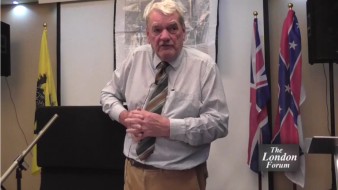
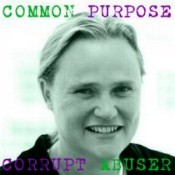
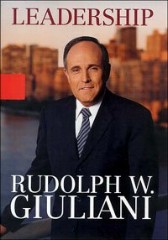

 and reliant on their votes, was killed by Blair, an unsuccessful barrister spotted as a substitute for a leader. He (1) ran up huge paper-money debts, of course to Jews; (2) arranged huge pointless construction programmes; (3) used ‘Private Finance Initiatives’ to guarantee unworkable interest rates; (4) paid out for countless charities, ‘think tanks’, advisory groups, non-white race groups etc, all following Jewish policies; (5) of course corrupted the country with lies, for the second Iraq War; (6) used ‘statutory instruments’ to overturn planning decisions, give illegal immigrants money and housing, money for multiple ‘wives’ etc; (7) did his best to convert health services into profit-centres; (8) supported groups of thugs. Career civil servants, military, journalists and so on went along with all this.
and reliant on their votes, was killed by Blair, an unsuccessful barrister spotted as a substitute for a leader. He (1) ran up huge paper-money debts, of course to Jews; (2) arranged huge pointless construction programmes; (3) used ‘Private Finance Initiatives’ to guarantee unworkable interest rates; (4) paid out for countless charities, ‘think tanks’, advisory groups, non-white race groups etc, all following Jewish policies; (5) of course corrupted the country with lies, for the second Iraq War; (6) used ‘statutory instruments’ to overturn planning decisions, give illegal immigrants money and housing, money for multiple ‘wives’ etc; (7) did his best to convert health services into profit-centres; (8) supported groups of thugs. Career civil servants, military, journalists and so on went along with all this.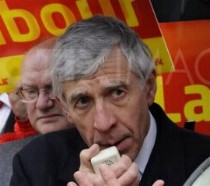 I’d guess despite huge incentives and advertising in Asia and Africa, not many immigrants trusted politicians. Hence the secret policy described by Andrew Neather. From 2001-2006 he was Foreign Secretary, positioned to push Blair into promoting Jewish war of the USA against Iraq.
I’d guess despite huge incentives and advertising in Asia and Africa, not many immigrants trusted politicians. Hence the secret policy described by Andrew Neather. From 2001-2006 he was Foreign Secretary, positioned to push Blair into promoting Jewish war of the USA against Iraq.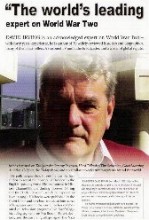

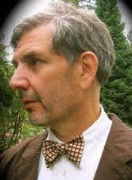
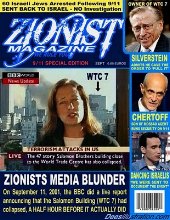 2001
2001 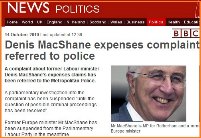 One of very many MPs who were/are semi-secretly Jews and with legal training. He helped draft NUJ instructions to prevent true race reporting. He supposedly represented Rotherham, a northern English constituency, and, among other things, imported Africans believed to have AIDS. This unspeakable piece of shit helped conceal rapes and assaults of underage white girls.
One of very many MPs who were/are semi-secretly Jews and with legal training. He helped draft NUJ instructions to prevent true race reporting. He supposedly represented Rotherham, a northern English constituency, and, among other things, imported Africans believed to have AIDS. This unspeakable piece of shit helped conceal rapes and assaults of underage white girls.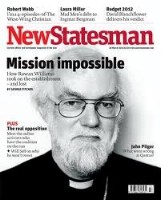
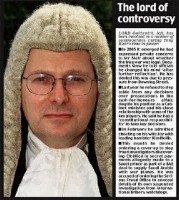

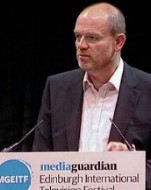

 was partly to get public assets into Jewish ownership, partly to keep the truth hidden about Jewish control of the USSR, the ‘Cold War’, Communism, and nuclear weapons. Another misunderstood issue is trade unions: under Jewish (‘red’) control, trouble could be caused where needed to close down industries, ports etc. Thatcher’s writings show she had no inkling. She was a perfect ‘useful idiot’—intense, single-minded and ignorant.
was partly to get public assets into Jewish ownership, partly to keep the truth hidden about Jewish control of the USSR, the ‘Cold War’, Communism, and nuclear weapons. Another misunderstood issue is trade unions: under Jewish (‘red’) control, trouble could be caused where needed to close down industries, ports etc. Thatcher’s writings show she had no inkling. She was a perfect ‘useful idiot’—intense, single-minded and ignorant.
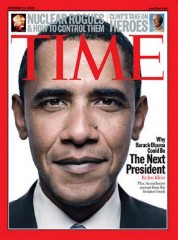 He is half Jewish, half Muslim—American blacks don’t seem to know Jews and Muslims dealt in black slaves for centuries. Supersitious love for the absurd ‘cult of the dead paedophile’. Promoted of course by Jews, surrounded by Jewish advisors, supporter of wars, illegal immigration, and de-industrialisation.
He is half Jewish, half Muslim—American blacks don’t seem to know Jews and Muslims dealt in black slaves for centuries. Supersitious love for the absurd ‘cult of the dead paedophile’. Promoted of course by Jews, surrounded by Jewish advisors, supporter of wars, illegal immigration, and de-industrialisation.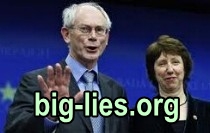
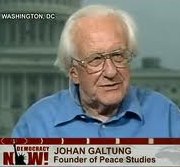

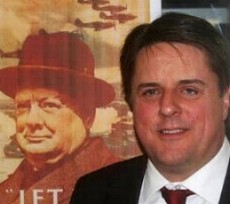
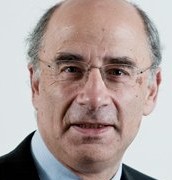



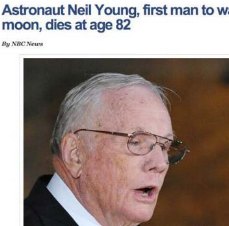

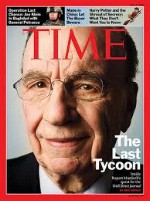 presides over a media empire, though probably he needed Jewish fake money to get it for him. He has an unrelieved and possibly unequalled history in telling lies, starting with genocide in Vietnam, and extending for decades to Iraq and beyond. He supports the Jewish agenda of forcing immigration into all white countries. Some time deliberate mass deception may be made illegal, and such freaks will die out.
presides over a media empire, though probably he needed Jewish fake money to get it for him. He has an unrelieved and possibly unequalled history in telling lies, starting with genocide in Vietnam, and extending for decades to Iraq and beyond. He supports the Jewish agenda of forcing immigration into all white countries. Some time deliberate mass deception may be made illegal, and such freaks will die out.

